
the Local Food and Drink of




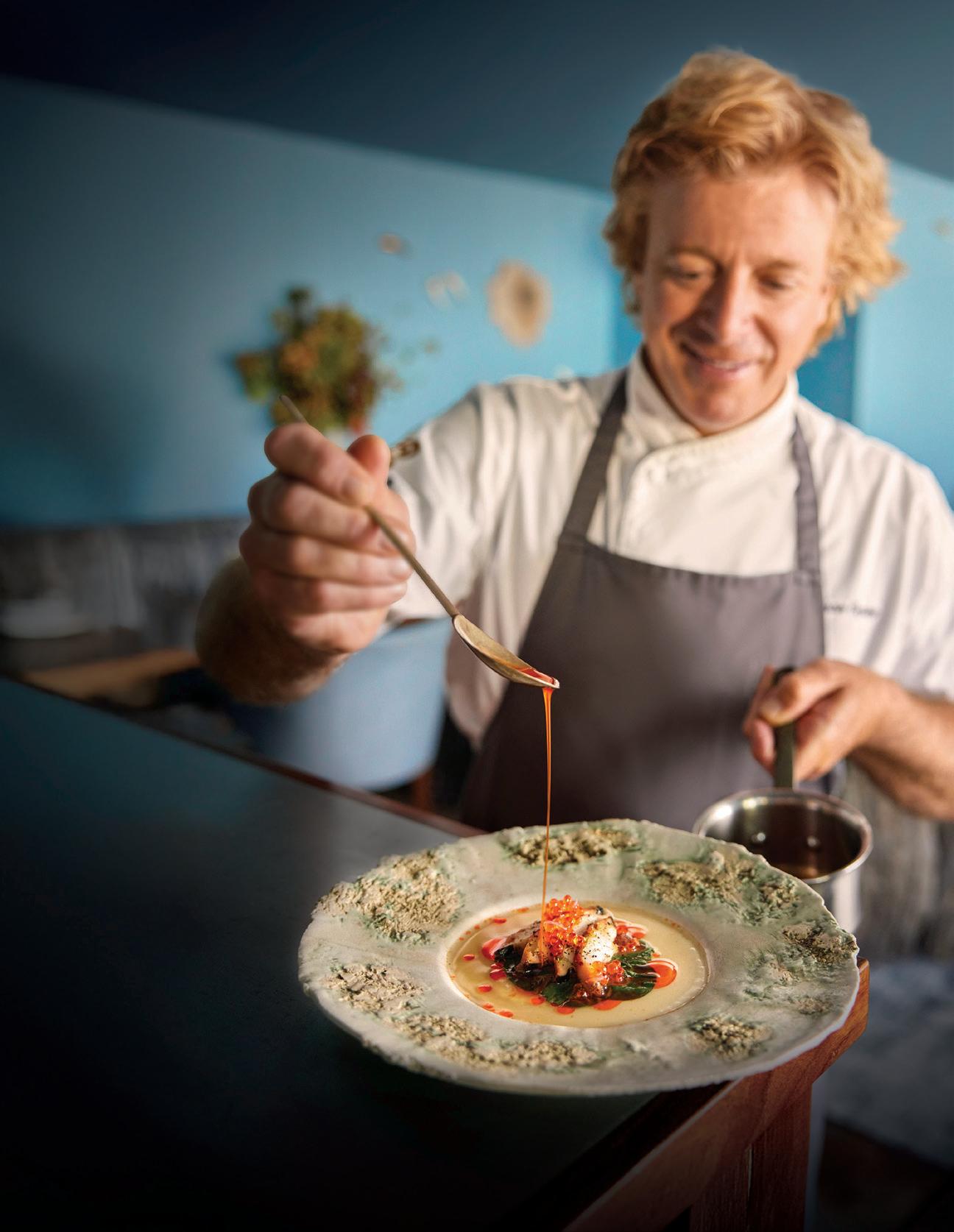


the Local Food and Drink of





Join us at Carmel-by-the-Sea Culinary Week for immersive food and wine experiences, curated menus, and special offers at participating restaurants—along with village-wide events throughout the week including the Party in the Plaza and Culinary Showdown. For more details and event calendar, visit CarmelCulinaryWeek.com
Market Magic: Melrose Cafe represents a breakthrough; Supreme Faith: A rare food trucker banks on the power of Nuevo Cairo cuisine; Together Through Tragedy: How a family rallies around Mmm Churros!
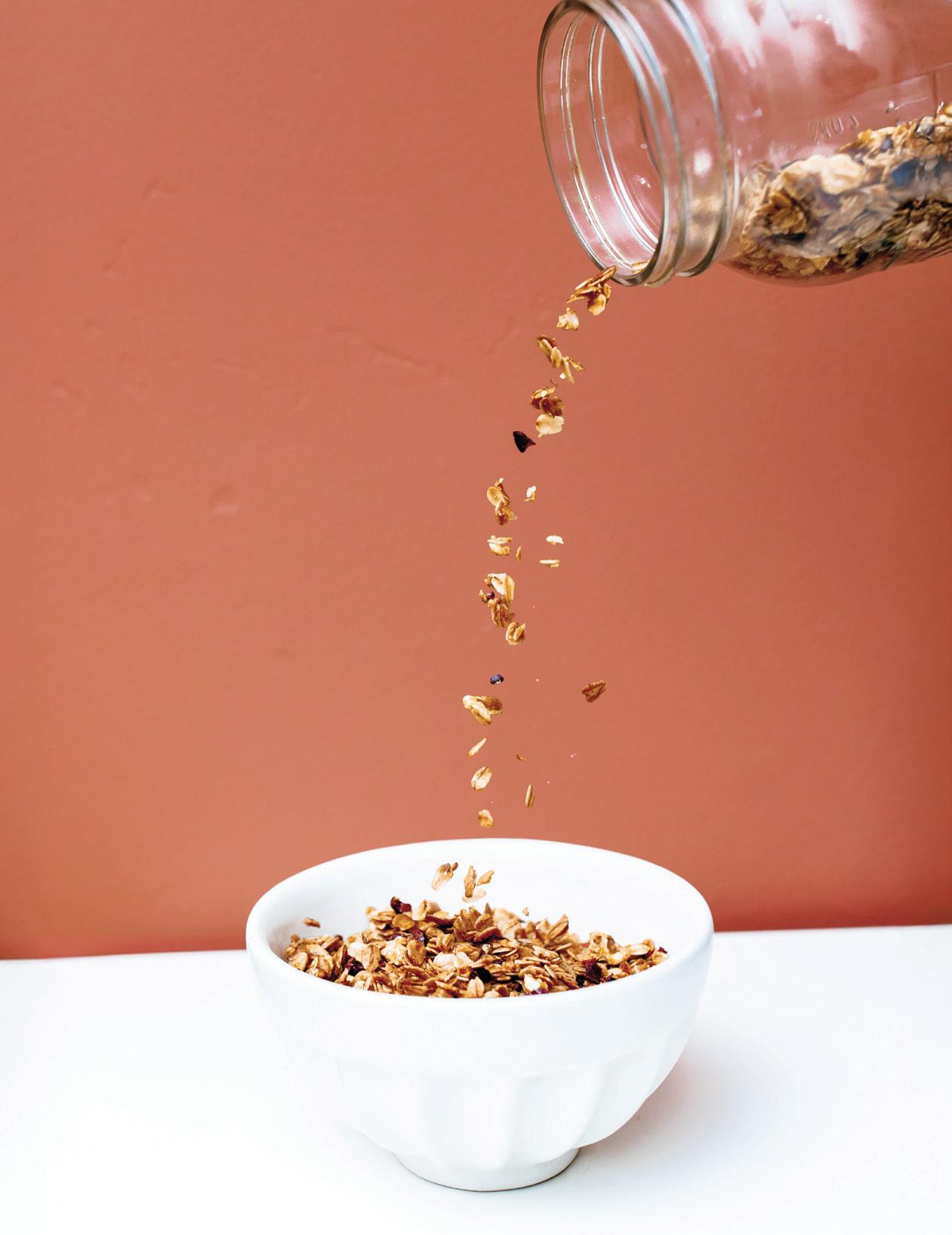
Learning
How—and why—six industry legends
Unlocking a special fruit for glorious prawns and bright
Joyce
Celery and Caramelized Date Salad with Goat Cheese and Toasted Walnuts
Shrimp in Tamarind Chipotle Sauce with Jicama Salad
Tamarind Mezcalita
Rose Petal Cocoa Nib Granola
Grain Free Coconut Lemon Granola
Tahini Berry Granola
involves





One of my favorite things about publishing Edible Monterey Bay is all the opportunities it provides me to get out and explore our beautiful tri-county region.
It’s easy for me to become a homebody living up in the Soquel Hills, but there are meetings to attend in Monterey, wine to pick up in Hollister, magazine deliveries to make in Carmel, events to go to in Big Sur, restaurants to try in Capitola and sometimes—if I’m lucky—a photo shoot up on the North Coast.
I hope this issue inspires our readers to get out of their comfort zones and explore some of the lesser-known corners of the Monterey Bay area.
Spring is the perfect time for it, while the hills are still emerald green from the rains and the wildflowers start popping. I can’t wait to see the purple lupine along Highway 68 on the way to Salinas!

In this issue, two new advertising partners join us, encouraging you to do just that. Visit San Benito County tempts us with horses and its cowboy heritage, while Salinas City Center offers a handy pull-out guide to the restaurants, bars, bakeries and coffee shops creating a new liveliness in its downtown.
They join ongoing tourism partners like Capitola Village, Spirit of San Juan Bautista and Hollister Downtown Association—all looking forward to your visit this spring.
Also new in this issue, we welcome longtime contributor Mark C. Anderson as managing editor. This means he has worked with our talented team of writers and photographers, preparing a feast of fascinating stories and gorgeous images for you to savor.
We introduce you to some of the unsung heroes who work behind the scenes in the Santa Cruz restaurant trade, a farmers market chef, a food truck entrepreneur and a family that is trying to carry on with their churro business despite a tragic loss.
We also have springtime recipes with new twists on familiar flavors like grilled artichokes and crunchy granola, as well as tips on how to use the more exotic flavor of tamarind. Eat, drink, think and explore with us.

Deborah Luhrman Publisher

EDITOR AND PUBLISHER
Deborah Luhrman
deborah@ediblemontereybay.com
831.600.8281
FOUNDERS
Sarah Wood and Rob Fisher
MANAGING EDITOR
Mark C. Anderson
COPY EDITOR
Doresa Banning
LAYOUT & DESIGN
Matthew Freeman and Tina Bossy-Freeman
AD PRODUCTION COORDINATOR
Tracy Smith
AD DESIGNERS
Louise Androlia • Julie Greene • Coline LeConte • tracysmithstudio • Sarah Williams
CONTRIBUTORS
Analuisa Béjar • Robert Eliason • Kelly Rose Evans • Agnieszka Kazmierczak • Alex Luhrman
• Michelle Magdalena • Anina Marcus • Laurel Miller • Laura Ness • Ashley Drew Owen • Geneva Rico • Patrick Tregenza • Amber Turpin
• Patrice Vecchione
ADVERTISING SALES
ads@ediblemontereybay.com • 831.600.8281
Shelby Lambert shelby@ediblemontereybay.com
Kate Robbins kate@ediblemontereybay.com
Aga Simpson aga@ediblemontereybay.com
Fran Fitzharris fran@ediblemontereybay.com
DISTRIBUTION MANAGER
Mick Freeman • 831.419.2975
CONTACT US:
Edible Monterey Bay P.O. Box 487 Santa Cruz, CA 95061 ediblemontereybay.com 831.600.8281
info@ediblemontereybay.com
At Edible Monterey Bay , our mission is to celebrate the local food culture of Santa Cruz, San Benito and Monterey counties, season by season. We believe in sustainability, and we believe everyone has a right to healthful, clean and affordable food. We think knowing where our food comes from is powerful, and we hope our magazine, website and newsletters inspire readers to get to know and support our local growers, fishers, chefs, vintners and food artisans.





Superlative focaccia sandwiches are popping up at Santa Cruz farmers markets, thanks to a new incubator program
BY LAUREL MILLER PHOTOGRAPHY BY GENEVA RICO


On any given weekend at the Westside and Live Oak farmers markets, there’s a line in front of Melrose Cafe’s butter-colored tent.
Owner/baker Cameron Meyers can usually be found taking orders or helping her employees assemble her seasonally stuffed focaccia sandwiches.
The pop-up offers a standard breakfast version, with fried egg, arugula, scallion, avocado and Asiago, as well as rotating specials. Depending on the season, there are treats like Fogline Farm porchetta with shaved fennel, apple and mustard seed vinaigrette; an outstanding BLT; or roasted carrots with whipped feta, pistachio pesto, frisée, caramelized leeks and spiced honey.
Meyers, a native of Santa Cruz, grew up in a family of avid home cooks, but her first kitchen job was working the pantry station at La Posta, at 19, under thenexecutive chef Katherine Stern. Meyers worked her way up to line cook, eventually moving on to Bantam in Santa Cruz and Home in Soquel.
“Spring is my favorite time for produce,” Cameron Meyers says—which means focaccia sandwiches made with fava beans, peas, asparagus, artichokes and fresh chevre.
In 2020, Meyers helped Stern launch her pandemic-era Midway pop-up at the Westside and Live Oak farmers markets—and spent her summers helming the kitchen at Kachemak Bay Wilderness Lodge in Alaska.
Last fall, Meyers launched Melrose Cafe, with help from longtime Santa Cruz Community Farmers Market Executive Director Nesh Dhillon. “Like Katherine, Cameron’s ethos was right in line with what we wanted,” Dhillon says.
When Stern discontinued her pop-up to focus on The Midway’s brick-and-mortar eatery, Dhillon and his team sought a replacement who also prioritized seasonal ingredients sourced from the market. When Meyers approached him in October of 2023, the timing was serendipitous.
Cameron Meyers at her Melrose post (left), at one of the local markets Nesh Dhillon calls, “jumping off points for creative people who have bigger plans, whether that’s a brick-andmortar or wholesale business.”
“Cameron understood what we needed,” says Dhillon. “She saw
the process of development and execution with The Midway pop-up, and the market needed another farm-to-pop-up prepared food concept built around a dedicated seasonal approach and commitment to the growers. And her focaccia is amazing.”
Meyers, for her part, is equally impressed with Dhillon and his team. “He’s such a strong proponent [of] community involvement, and the markets themselves are such a special place—a lot of that is because of him,” she says. “He really pushes to make things happen.”
As for that amazing focaccia, it’s rare to find a self-taught baker with Meyers’ talent. She initially began baking “for fun,” but in Alaska, she found it useful, as sourcing was limited. In addition to smoking her own meat and fish, she made her own yogurt and baked goods, including a fluffy focaccia.
“I developed a recipe that didn’t require starter, just overnight proofing,” she says. When Nesh and I first connected, I had this half-formed idea that I wanted to do focaccia sandwiches.”
Dhillon and Meyers began fleshing out the concept, with a view toward making Melrose a model for future prepared-food vendors and farms selling valueadded items from their produce, like jam, salsa and pickles.

“The idea of empowering food offerings at the markets is something I’ve thought about for a long time,” says Dhillon, noting every market is different, from location and demographics to vendor composition, timing and location. “If you don’t have a customer base showing up, your business won’t work—markets have to create infrastructure that supports and pays for itself. But they’re also flexible and dynamic, and able to pivot easier than a restaurant or grocery store.”
He adds it’s imperative that all vendors are a good fit and fill a niche within their specific markets. To ensure that, he helps new vendors go into the season with a plan and “see it through, so we have empirical data instead of conjectures.”
“There’s a method to all of it, so we can devise a bigger picture,” he says.
While some prepared food vendors do source specific ingredients from their fellow growers, Dhillon’s goal is to fully vertically integrate new businesses as the markets grow into their next phase of development, which will coincide with the relocation of the downtown market and de-


ucts at the downtown market. She eventually increased her range to 14 markets throughout
Melrose Cafe also sells quarter-loaves and the occasional pastry special, like coffeecake. Rainy days expand to include grilled cheese or soup, like San Marzano tomato with but-
“As a former market vendor [for Pescadero’s celebrated Blue House Farm], I know what it’s like to work when it’s cold and slow,” Meyers says. “I wanted to support the vendors by giving them something hot
Because the pop-up launched in September, Meyers has yet to experience a full season, but she’s excited for spring—“My favorite time for produce,” she says—which means sandwiches made with fava beans, peas, asparagus, artichokes and fresh chevre.
As for the future, Meyers says her plate is
“We’re figuring it out as we go,” she says. “I’m a big fan of waiting to see what
l Miller is a food, drink and travel writer . She grew up on a California ranch and has been writing about regenerative agriculture for over 20 years. When she’s not tethered to her laptop, Miller works at the farmers market. She enjoys backpacking, agave spirits and street tacos, not neces-
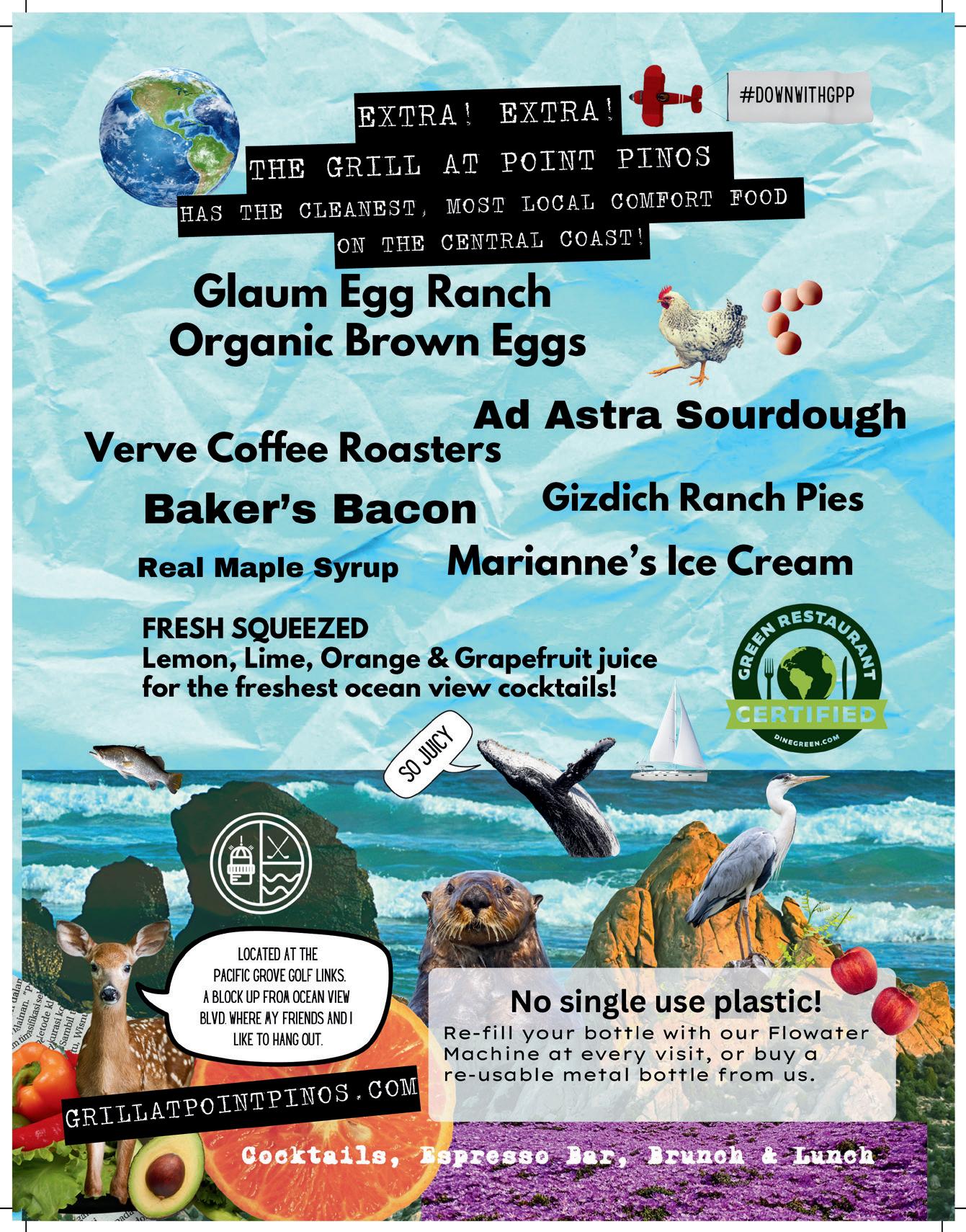

BY ANINA MARCUS
PHOTOGRPAHY BY MICHELLE MAGDALENA
Along way from the Nile Delta where he grew up in Egypt, Sam Shokir—owner of Nuevo Cairo Mediterranean Street Food food truck—has finally found his spot. Located in downtown Monterey at the busy intersection of Abrego and Fremont streets, the truck’s flashy exterior of bright reds, oranges and Kermit the frog green is hard to miss. At first glance, you might even mistake it for a Mexican taco truck.
“Well, the previous owner was Egyptian,” says Shokir, “but the cook was Mexican, so yes the food was mostly tacos. I changed the food to Middle Eastern, but I really want something for everybody because it is not about me. It’s all about the customers.”
Shokir is a big guy with smiley eyes and a bouncy step, always ready to greet you. Strike that. He is thrilled you have arrived at his truck and when he asks your name, he will not forget it. A young man walks up to the truck and pays for his meal from a few weeks ago. “No problem,” says Shokir, gesturing with a flick of his wrist.
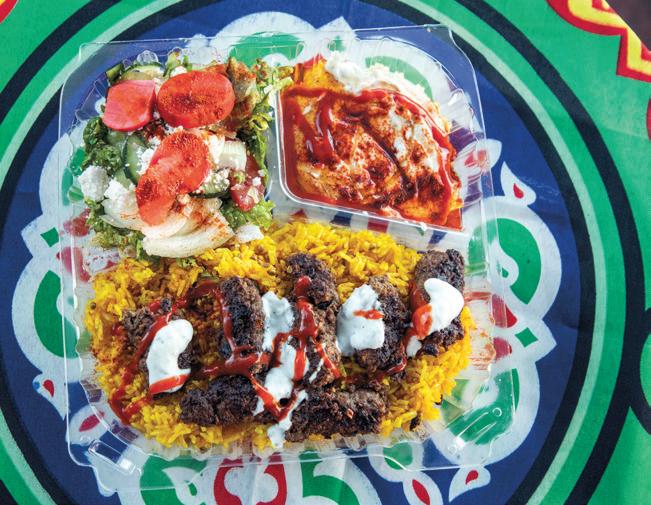
He bends his large frame forward to peer through the tiny window to take orders, while a belly dance rhythm of bells, strings and drums comes through the speakers.
Chicken and lamb shawarma (marinated thin slices of meat in cumin, turmeric and paprika stacked on a vertical rotisserie) are available, along with falafels and kebabs, Shokir also offers up Philly cheesesteaks, garlic and curry fries, egg rolls and hotdogs.
drops them quickly into hot vegetable oil flavored with pieces of fresh onion (for a richer smell). After five or six minutes, he pulls out the falafels with a strainer, then layers them on a whole pita bread with eight different toppings each cut in perfect dimensions: radishes, lettuce, tomatoes, red onion, Greek olives, feta, cucumbers and carrots. Lastly, he drizzles his homemade tzatziki sauce over the entire sandwich, wraps it up into a cone and stuffs it into paper wrapping.
Shokir came to America in 2008, when he was 27 years old, because as he explains coyly, “A woman catches me.”
At first, he alternated between jobs, working the Monterey Farmers Market with a Syrian friend and working for another friend who owned Star 1 Gas in Salinas. Then he worked for Monterey-Salinas Transit, helping those in wheelchairs get on and off the bus to get to medical appointments.
Sam Shokir’s most popular items include shawarma plates, kebabs, hummus and falafel.
Starting at 6am every morning, Shokir prepares his signature falafel—a mixture of ground fava beans and chickpeas, cumin, cilantro and garlic. “I start everything fresh from A to Z,” he says, while demonstrating a special tool he uses to mold each falafel patty. He
When his father-in-law retired from a job at Soledad Prison after 20 years, he was even handed the position of chaplain of Islamic

Services. He was there to counsel and pray with American Muslim prisoners serving life sentences and was put in charge of finding halal food for Muslim inmates, but Shokir lasted just eight months.
After emigrating—but before rolling out his own truck—Shokir worked as everything from a taxi driver to a prison chaplain.
“It was the sound of the electronic gates shutting when alarms went off four or five times a day, signaling some kind of attack or outbreak,” he remembers. “All they gave me was a whistle, so I feared for my life.”
He soon found work as a driver: taxis, Uber and eventually DoorDash.
Although he grew up working in his father’s restaurants and supermarkets in Alexandria, Egypt, he didn’t consider himself a cook and never thought the food business was for him.
It was during the beginning months of COVID, when he started driving for DoorDash, that he saw how much money was spent on food and began to think about opening a café—a place where people could find more affordable food, tastier coffee and pastries, and community.
Trying to open the café took years of work and depleted his funds.
“Inshallah,” (as Allah wills it) Shokir recounts, “I came to have coffee early one morning at 5am with a friend who owns this gas station in Monterey. He told me the food truck was available to rent and then ultimately to buy, so I started the very next day!”
Framed prints of a gondola ride in Venice and amaryllis flowers lean against the bottom of the truck, while an outside shelf offers small
Although he grew up working in his father’s restaurants and supermarkets in Alexandria, Egypt, he didn’t consider himself a cook and never thought the food business was for him.
plastic containers of baba ghanoush, hummus, baklava, toasted sesame and sugar bars and Medjool dates. If you look a little closer, you will even see stacks of paperback copies of the Koran for sale.
Shokir is the decorator, the cook, the buyer, the dishwasher and the marketer. I ask him again if he will tell me the seven secret spices he uses to flavor the lamb, chicken and beef, but instead he grabs a chef’s knife and dazzles me with his skills, transforming a giant head of lettuce into long thin uniform ribbons, not ever looking down at his hands—just like he watched his father do when he was just a kid. He finds his bag of spice powder and shows me three spices written on it: dried mandarin peel, star anise and dried fennel.
“I can’t tell you the other four. Just eat,” he says, “that’s my secret.”
Shokir’s dream of opening a brick-and-mortar eatery is still alive and, as of press time, he was preparing to open his Habibi Mediterranean Cafe on Lighthouse Avenue within weeks.
“Hamdullah,” he says, waving his hands in the air. “Hamdullah, Hamdullah, Hamdullah.” With Allah’s blessings. Then he spots one of the crows that makes daily appearances and jumps down from the truck with a few falafel balls to feed it. “You see, even the birds are my friends too!”
Nuevo Cairo Mediterranean Street Food 398 Fremont St., Monterey Habibi Mediterranean Cafe 225 Lighthouse Ave., Monterey
Anina Marcus works as a physical therapist in her day job, helping people get back on their feet. When not doing that, she is thinking about what to make for dinner, perfecting the ears on her sourdough breads and trying to find enough time in the day to daydream. She can be reached at aninamar12@gmail.com.



How the Mmm Churros! family is recuperating— and making great food—after a tragic loss
BY ASHLEY DREW OWEN
PHOTOGRAPHY BY ROBERT ELIASON

Mike Jones never imagined his lifelong love of churros would inspire him to launch a burgeoning business with his wife and high school sweetheart, Priscilla.
He never thought their idea, Mmm Churros!, would evolve into a festival-favorite pop-up and then a café, giving them a permanent place to get creative with their preferred dessert.
He also never imagined doing any of it without Priscilla by his side.
After years of working tirelessly to create Mmm Churros!, and right after opening a brand new storefront in their adopted hometown of Hollister, the Jones family was dealt an unquantifiable loss.
In October 2024, eight days after the opening of their store on Tres Pinos Road, Priscilla—a beacon in their family and community—died in a car accident. She was driving to her primary job as a graveyard shift 911 dispatcher.
Everything at Mmm stopped.
After a couple months of processing and soul searching, Jones reopened the doors. His ongoing hope is to keep the vision he and his wife shared alive for their kids.
He also doesn’t know exactly what else to do.
Long before Mike and Priscilla met and fell in love as teenagers, they forged fond memories of frequenting the area’s many churro carts with their families around East San Jose.
Once they married and had a family of their own, they’d often take their little ones to experience the joys of Disneyland. When they
saw churros around the park and shared their favorite dessert with their kids, they realized good churros weren’t guaranteed.
“We know what an authentic churro tastes like and this was not it,” Mike says. “So I told [Priscilla], ‘We should make churros.’”
A hazy version of a family business had been floating around for years. Then one night Priscilla sketched out a logo and things started feeling real. The couple began serious conversations about the venture while drawing up a business plan.
This was all in between raising their three children, Priscilla’s fulltime role as a law enforcement and medical dispatcher for Santa Clara County, and Mike’s job in sales and distribution for corporations like Coca-Cola and FritoLay.
The first big step: develop the recipe. Over two years, Mike learned how to dial in temperature and time, working toward their vision for an ideal churro—with a crispy-crunchy outside and delightfully fluffy interior—just like he and Priscilla loved growing up.
“I’m not a baker or anything, so this was a lot of trial and error,” Mike says. “It would be a lot of nights staying up making dough and texting my wife—while she was working—about how the batches were coming out.”
From there, they product tested in the neighborhood and started selling out of their home. At first they offered boxes of a dozen, as well as shapes like hearts, short “bites” and flavors that included oldschool cinnamon sugar and experimental varieties like grape and watermelon.
From day one, the Jones children have been integral to the business. “When we first started, it was just us five,” Mike Jones says. “It feels good that they are able to learn the business.”
When the pandemic hit, they went all in. Mike quit his job and the couple put their stimulus checks—and their free time—into the operation.

“When you support small businesses like us, you’re not just buying a coffee or a treat,” Mike says. “You’re supporting a family’s dream.”
“That’s the only thing that we [had] to get started,” he says.
The Jones family hustled around the clock to fill the growing number of orders. While Mike ran the operation fulltime, Priscilla juggled many roles.
On any given day she fielded 911 calls all night, then helped run the business and be what her friends described as a “super woman and super mom.”
“Priscilla was one of those moms who seemed to tackle anything head on, and with grace…she was one in a million.”

In addition to her work, she played an active role in her kids’ school events (often with churros in hand), participated in organizations like the Downtown Association and even launched a neighborhood watch.
As events re-emerged post-pandemic, the Joneses went mobile. Farmers markets and catering gigs turned into bigger and bigger events. The family’s positive energy, obsession with their craft and unique products helped them form relationships in the event world, and before long Mmm Churros! was an official partner of the Monterey Bay Football Club, and a regular fixture at the annual California Roots Music & Art Festival.
“Mmm Churros! was easy to work with, but—more importantly—Priscilla and Mike inspire us, and often all of their kids were in the booth working right alongside,” says Amy Sheehan, Cali Roots co-owner and co-producer. “Priscilla was one of those moms who seemed to tackle anything head on, and with grace…she was one in a million.”
As their churros took off, the next phase came into focus: a café that served churro affogatos, and other pastries in the morning, and


stayed open late for desserts like decadent churro sundaes and hot chocolate.
A stable home kitchen would allow them to keep their crowd pleasers (like their box of churros and churro bite bowls) and expand on the creative confections they had become known for—churros filled with caramel and topped with crushed peanuts and chocolate drizzle, and a bowl of churro bites topped with bacon bits and maple syrup.
When the opportunity to open a brickand-mortar in Salinas presented itself in 2023, they went for it. After a successful year in Salinas, plus an active pop-up schedule, they jumped at the chance to relocate the business to Hollister.
Their opening day in October 2024 was one to remember. Friends, family and community members came out to support, as did many regular customers.
“In the midst of the chaos in opening a new location, I was forced to stop and take it all in when I saw my youngest baby sleeping in the window as I walked up,” Priscilla wrote in an Instagram post after opening. “I was stressed beyond measure from working literally all night, running errands and fighting traffic to make it back in time. But the sight of this sweet little face sleeping so innocently in the window made me literally stop in my tracks and think back to why we do what we do.”
Then, just a few days later, everything changed. Mike and his children received the worst news they could get. Sympathy, tributes, prayers, memories and support
flooded in. Hundreds of people attended the candlelight vigil for Priscilla the day after her accident.
For a while, Mike didn’t know if he had the heart to continue the business. He sometimes doesn’t know how he can keep going.
“It’s extremely difficult every day. The feeling of being here without her isn’t right,” he says. “She was unstoppable. She would work a 14-hour shift and then come to the business. She wanted to be here. And she knew it could be what we wanted it to be.”
Fueled by his drive to uphold Priscilla’s memory, he decided to reopen the shop in early December, and the Mmm Churros! community came out to show their love. Mike also plans to dive back into a pop-up schedule come springtime and continue bringing his family’s creative take on churros to events throughout the region.
Though things will never feel normal again, he gets through it by remembering what drives him.
“Our main reason for doing this was our kids, everything we do is for them— make sure you know your why,” he says. “I got hit with a hard blow of losing my wife, and the kids losing their mom. It’s about taking the time to think about why we did it in the first place and continuing the legacy for her.”
Ashley Drew Owen is a writer and public relations pro for sustainable produce. Her passion for local food is only overshadowed by her passion for eating it. When she’s not nerding out about food, she can be found exploring nature with her dog, Fenn.






STORY
BY MARK C. ANDERSON
Tink, in her seven pounds of Yorkshire terrier glory, may not have given off mighty-artichoke-warrior vibes.
But, oh, if you could’ve seen her work. She took her security duties personally.
Tink would stalk the rows of heirloom artichokes in the Castroville fields at Pezzini Farms just off Highway 1, where her wider Pezzini family is now going on its fifth generation of artichoke growers. When she sensed a mouse, her ears would pop up, and she’d bark an alert.
Sometimes she’d bring Kona, the big black German shepherd, to do the heavy digging. Most of the time Tony Pezzini—whose grandpa started growing artichokes at Odello’s Carmel farm in 1929— would accompany her, helping flush out the marauders with a shovel so she could pounce.

“Every day we’d go out, and if I wasn’t out there, she was out there,” he says. “We had a system: I’d get on one side, scare the mice towards her, then she would dig, and take them out. It was amazing.”
The kill tally he kept over months and years eventually reached 3,500. Tink’s record for a single day: 58.
Tink and Tony were inseparable, hence Pezzini’s grief when she died.
“It was hard,” he says. “At least I had her in my arms, walking around with her, talking with her…then she got heavy, and she was gone.”
Tink is far from the only star woven into local artichoke lore. Norma Jean, before she changed her name to Marilyn Monroe, famously won the first Artichoke Festival queen crown. More recently, heavy hitters like Bobby Flay, Martha Stewart and Lidia Bastianich have highlighted the farmstand, where The Choke Coach food truck is layered with photos of famous customers like celebrity chef Curtis Stone.
Monterey County produces about 70% of the nation’s artichokes, and California nearly 100%; Castroville-based and family-owned Ocean Mist Farms, which turned 100 last year, harvests the vast majority of those.

And Tink’s valiant service spotlights the type of heirloom green globe artichokes the Pezzinis choose to grow. The deep root systems of the perennials variety allow for multiple harvests from one plant, and artichokes that develop thicker and tastier hearts, but also make the plants popular with rodents. (Other growers opt for annual artichokes that are more affordable to grow but yield smaller hearts and one harvest per plant.)
The most important point revealed by Tink’s teamwork is how familial an undertaking this is.
Tony and his son Sean filter out into the fields with their team as early as 5am during spring harvest season. The two hand pack every artichoke they direct ship across the country. Sean hand picks every sauce, spice and apron in their wonderland of a farm stand, where his young son is already learning how to work the forklift controls from dad’s lap.
In other words, when it comes to the country’s best artichokes, the area’s most brilliant springtime crop, and the state’s official vegetable, it gets personal.
When it comes to the country’s best artichokes, the area’s most brilliant springtime crop, and the state’s official vegetable, it gets personal.

“Artichokes are fun and unique and, for a lot of people, a specialty crop,” says Sean Pezzini (above left), with Tony. “They make people happy.” Below right, artichoke sorting starts the completely hands-on prep process at Monterey Farms.
A hair-netted, face-masked and lab-coated worker slices artichokes in half, with speed. Another whittles away at the leaves of an artichoke, quickly and gracefully taking it down to its heart. Another worker pulls pans of chopped hearts from a steamer and assembles them on a vintage charbroiler. Yet another sorts artichokes from a mountain big enough to fill five hot tubs.
Monterey Farms, tucked on an industrial street in Salinas, is aswirl with activity, a Willy Wonka Artichoke Factory. Founder, President and Chef Jane Hayes weaves through prep
kitchen, nabbing a freshly grilled slice of artichoke heart to taste test. Then she pauses to point out a brand new product that hits markets mid-year, ArtiQs—a fresh cooked, vacuum-sealed and halved artichoke, ready for a restaurant chef or home cook—and her emotion is audible.
“This has been a dream of mine for 10 years,” she says. “I’ve been able to take this amazingly healthy, unique vegetable and provide real value added.”
Her whole operation proves seductive to a thoughtful eater, and outright orgasmic to an artichoke fan.
Doing everything by hand, she and her team rescue artichokes deemed too flawed to sell whole—because they might look a little iffy from frostbite or have a hole in a leaf—hand-trim them to their hearts
and give the leaves to local beef ranchers whose cows love to munch them.
Then those hearts are steamed, grilled, flavored and tucked in handy packets, ready for a pizza, pasta, salad, frittata or easy snack, without the work—or mushiness, brine, oils or leaves of often imported jarred hearts.
A waste stream becomes a prized product—and one whose simple freshness and flavor speaks to the thought that went into it.
“When cooked properly, our fresh artichoke hearts add an element of richness and complexity to a meal not found anywhere else,” Hayes says. “I have vegetarian customers tell me that our artichoke hearts are a delicious substitute for meat.”
Artichokes are flower buds, pre-blossom, and a member of the daisy family. (Hayes, in fact, has trademarked “The Incredible







Tapas Happy Hour, 4:30–6pm
Dinner starting at 4:30pm
Brunch Saturday & Sunday 9am–1:30pm
Open for Breakfast daily
Pet-Friendly Patio
Edible Flower” for her line of prepped
When they’re fresh, an artichoke squeeze will result in a rubbery squeak, so shop accordingly. (Sean Pezzini also coaches buyers to look for longer, thicker, stronger stems, as those tell you more about the heart meat inside.)
Artichokes are one of the oldest cultivated vegetables, originating from the Mediterranean region around 3,000 years ago, include scores of various varieties and are high in fiber, antioxidants and cynarin, which enhances liver function and aids digestion.
But while there is a bumper crop of fun artichoke facts out there—surprise, Egypt produces the most!—there are even more
While the cooking demos, live music and Agro Art have their merits, that has long been the major draw of the Artichoke Festival, happening June 14–15, 2025, at the Sheriff’s Posse Grounds in Salinas.
A partial list of potential preparations includes fried, sautéed, grilled, marinated, pickled, thin-sliced carpaccio style, and starring in and on soups, sandwiches, risottos, quiches, hummus, pizza, bruschetta, ice cream and cupcakes.
The delicious thistle’s culinary map found fresh expression last year when Monterey County Convention & Visitors Bureau debuted The Artichoke Trail, which lists 40 different restaurants, stores, attractions, bars and farm stands dedicated to the Cynara cardunculus.
The guide works as culinary inspiration and flavor invitation. Chocolate in down-
Luca Pezzini, 4, helps farm stand manager Mary Aleman tend the register on the regular.
town Santa Cruz, for instance, does handrolled pasta in an artichoke cream sauce and a “sizzling” pot of artichoke hearts, melted Asiago and ricotta cheeses and white wine. Flaherty’s Seafood Grill & Oyster Bar crafts a crab and fire-roasted artichoke quesadilla. And the likes of Cella restaurant and Pearl Hour, both in Monterey, do clever cocktails with artichoke amaro.
Pezzini Farms’ Farm Stand appears on the list, with its artichoke cupcake center stage.
The dessert works as a tiny taste of the vast inventory curated to feature thoroughly local products, an Artichoke-Festival-untoitself, with artichoke drizzles, artichoke bruschetta, artichoke pasta sauces, artichoke aioli, and boxes and boxes of fresh heirloom artichokes.
It’s at the Farm Stand that a fifth-generation Pezzini can occasionally be found running the register with help from Mary Aleman, farm stand manager and Castroville’s unofficial mayor.
Though he just turned four, the kid’s clearly got a knack for the business.
It runs in the family, sure, but this artichoke part of the area’s flavor profile only works because Luca, like his parents, grandparents and great grandparents, takes a personal interest.
Mark C. Anderson is a writer, photographer and Edible Monterey Bay’s managing editor.
experience jacks monterey inside the portola hotel & spa

handcrafted cocktails & award-winning wines on the pet-friendly outdoor terrace with fire pits
seasonal cuisine from locally sourced ingredients for breakfast or dinner
in our tree-lined atrium dining room or cozy fireside bar
locals discount & complimentary self or valet parking

Courtesy Sean Pezzini, co-director, Pezzini Farms in Castroville
The fourth-generation artichoke farmer is also the best chef in the family, according to his parents. His favorite ways to prepare it number two: 1) a quick fry for lightly breaded baby artichokes, and 2) this classic grill approach, which he calls, “my go-to and favorite.” One special thing to observe is the magic of their house Pezzini Farms Artichoke Seasoning. It’s a wonder drug that works nicely on everything, from eggs to toast to pizza to pasta to, yes, artichokes, which works well with all those things too.
4 large to jumbo artichokes
4 tablespoons olive oil
4 teaspoons Pezzini Farms Artichoke Seasoning (or an Italian style seasoning)
2 lemons
Fill a large pot with 2–3 inches of water and add a vegetable steaming rack or four artichoke steamers. Bring water to a gentle boil. While you are waiting for the water, prepare your artichokes.
Trim the very ends of the stems and cut about 1 inch off the top of the artichokes (a serrated knife works best for this). You can trim off the thorns of the petals with scissors, if you like. We usually leave them if we’re cooking for our family but trim them if preparing them for guests.
Place artichokes on the steam racks with the stems facing up. Reduce heat to medium and cover pot. Steam for about 30 minutes depending on the size of your artichokes. You can check if they’re cooked by putting a knife into the base of the stem. The knife should slide in fairly easily with just a bit of resistance. We like to cook our artichokes until they are “al dente” or about 5 minutes
shy of being fully cooked since they will be finished on the grill.
Turn on the grill and get it to around 450–500° F while waiting for the artichokes to cool down.
Once cool enough to handle, cut artichokes in half lengthwise. Remove the choke (the inedible spiky and fuzzy part of the artichoke) with a paring knife by sliding the knife right along the underside of the fuzzy choke then pulling the fuzz and spiky leaves out. Be careful not to cut too far down underneath the fuzz or you risk cutting out some of the heart.
In a small bowl, stir together the olive oil, the juice of ½ lemon and the seasoning. Brush the mixture on all sides of the artichoke.
Place artichokes cut side down on the hot grill for about 3 minutes with lid closed. Once you get some nice grill marks and a bit of char, flip the artichokes over and cook for 2–3 more minutes.
Serve with the remaining lemon, cut into wedges, and your favorite dipping sauce. We usually go with a lemon aioli or a garlic Dijon (both available at Pezzini Farms!). Serves 4–6.
Pezzini Pro Tips
We recommend steaming artichokes instead of boiling them as they can become waterlogged from boiling and lose their flavor. We place them upside down (stem facing up) so the steam rises up between the leaves and cooks them a bit faster and more evenly.
Leave as much of the stem on as possible when preparing them. The stem is an extension of the heart, so the inside of the stem is edible.
Artichokes oxidize (turn brown) very quickly when they are cut during preparation. To prevent this, have a cut lemon handy and rub the lemon on any parts of the artichoke you cut.
When picking out an artichoke, look for a thick and long stem. This usually means a larger heart. Wiggle the stem. It should be firm and not move much. If it feels rubbery and bends like an old carrot, it’s probably 1–2 weeks old and should be avoided. The artichoke should also feel dense for its size.
Store artichokes in the refrigerator. If they are fresh, they should last at least a week refrigerated.



GrANNola and Sourdough Flats
Chime Foods | Hollister @windchimefoods | windchimefoods.com Handcrafted Ceramics by Anisa Etemadi, Cara Byrd, Donna Kline, Fran Foote, Holly Lee, Isabelle Olson, Margaret Hunt, Maria Tracy, Peggy Alonas, Vanessa Bredthauer
Peninsula Potters | 2078 Sunset Dr., Pacific Grove @peninsulapots | peninsulapottersca.com
Whimsical Floral Arrangement by Aga Kazmierczak Unskripted Design | unskripteddesign.com

STORY BY AMBER TURPIN
PHOTOGRAPHY BY Michelle Magdalena
Mandy Wetzel’s path to finding a home as a pastry chef in the redwoods, crafting alternative delicacies for retreat participants, has been an adventurous one.
It took her from the deep South, where she grew up, to Europe, then New Zealand, and finally here to California.
Now, as of the past three years, Mandy Wetzel has been exploring the art of creating gluten-free and plant-based desserts at 1440 Multiversity in Scotts Valley.
That’s where she is chef de cuisine, drawn to its mission of innovation and immersive community building in a forest retreat setting.
“I’ve developed a deep passion for transforming traditional desserts into versions that meet specific dietary needs without compromising on flavor or texture,” she says.
The position also allows for— in no particular order—hanging out in ancient woods, using seasonal ingredients from local farmers and the on-site Joanie’s Garden, and channeling her mom’s love for baking.
“Mandy has a unique talent for turning simple ingredients into delicious healthy delights [including] the gluten-free and vegan desserts on our menus,” he says. “Our guests—whether on campus for a healing program, private group retreat or community event—consistently rave about the desserts she prepares, how good they look and taste, along with how nourished they feel eating them.”
Wetzel sources artistry for her baking projects in many different places.
“Often, it’s the ingredients themselves that spark new ideas, whether it’s a seasonal fruit, a unique flavor combination or a specific dietary need,” she says. “But I also draw inspiration from nature, travel and even the people I work with.”
“I believe that inspiration can come from anywhere and everywhere, and it’s about keeping an open mind and staying curious.”
“She baked everything from scratch, and I loved helping her, especially when I got to lick the spoon!” Wetzel says, while acknowledging she initially saw baking as more of a hobby—until a friend told her about the baking and pastry arts degree offered at Johnson & Wales University in Rhode Island.
“After researching it, I knew it was the perfect fit,” she says. “I’m so grateful to be working in a field I’m passionate about, doing something I truly love.”
Eaters might be more grateful for that career discovery, since it has led to the cookie recipe (see recipe, page 30).
It is at once simple and approachable, while incorporating alternative ingredients to create something for anyone and everyone. That’s something Wetzel has a knack for, as 1440 Executive Chef Jose Fernandez points out.
Often, those interweave, she adds.
“Each new experience offers something fresh to explore, and I love experimenting with new techniques and flavors to see what works,” Wetzel says. “Ultimately, I believe that inspiration can come from anywhere and everywhere, and it’s about keeping an open mind and staying curious.”
That curiosity led to this cookie, highlighting one of Wetzel’s favorite seasonal fruits, namely the blueberries that remind her of growing up in South Carolina.
“I would check on the bushes each day, watching as the berries gradually grew bigger as the days grew warmer,” she says. “Picking them right off the bush and enjoying their sweet, tangy flavor became one of my favorite parts of the season.”
Amber Turpin is a freelance food and travel writer based in the Santa Cruz Mountains. She is a regular contributor to The Mercury News, 7x7, Marin Living and Diablo Magazine, with work appearing in Bon Appétit, BBC Travel, Thrillist and EatingWell. She is also a field coordinator for the Slow Wine Guide USA and story editor for Edible Silicon Valley
Courtesy Mandy Wetzel, chef de cuisine, 1440 Multiversity in Scotts Valley
1 cup plant-based butter, softened
¾ cup powdered sugar
1 teaspoon vanilla bean paste or extract
1 teaspoon almond extract
1 cup gluten-free flour
2 cups almond flour or meal
½ teaspoon salt
Blueberry compote (recipe follows)
Marcona almonds, toasted and chopped (for garnish)
Preheat your oven to 325° F.
In the bowl of a stand mixer fitted with the paddle attachment, cream the softened butter and powdered sugar together until smooth. Scrape down the sides of the bowl as needed. Add the almond extract and vanilla bean paste, mixing until fully combined.
Add the gluten-free flour, almond flour and salt. Mix until the dough comes together
and no dry spots remain. Be sure to scrape the bottom of the bowl to ensure everything is well incorporated.
Portion the dough into 2-inch balls and place them on a baking sheet lined with parchment paper. Flatten each ball slightly with your palm to create a cookie about ½-inch thick with a flat top.
Bake for 12 minutes, rotating the sheet halfway through to ensure even baking.
As soon as the cookies are out of the oven, gently press the back of a spoon into the center of each to form a small divot.
Fill each divot with the blueberry compote, about 2 teaspoons full, and return the cookies to the oven for an additional 2–3 minutes, allowing the filling to set.
Once out of the oven, top with toasted, chopped almonds for garnish.
Allow the cookies to cool completely before serving. Makes about 1 dozen.
For the blueberry compote
2 cups fresh or frozen blueberries
½ cup sugar
Zest and juice of 1 large lemon
In a small pot, combine the blueberries, sugar, lemon zest and lemon juice.
Cook over medium-low heat for about 15 minutes, stirring occasionally, until the mixture thickens. Set aside to cool.





• Use the right tools for mixing. This recipe calls for a stand mixer, which is perfect for creaming the butter and sugar to perfection. If you don’t have one, a hand mixer will work too, just be sure to cream the butter and powdered sugar until light and fluffy. This ensures the cookies have that melt-in-your-mouth shortbread texture.
• If you prefer using regular butter, it works great! Just be aware that it may cause the cookies to brown faster. If you go this route, check your cookies 2–3 minutes sooner than the recipe suggests.
• Gluten-free flour blends can vary in texture and absorbency, so accurate measurement is key. If you don’t have a scale, spoon the flour into your measuring cup and level it off with a knife for precision. If the dough feels a little dry, add a teaspoon or two of plant-based milk to bring it together.
• If you want to use regular, all purpose flour, that should be fine, though the cookies will most likely spread more than the gluten-free cookies, so if using regular flour, do not flatten them.

• Make sure the compote thickens enough to hold its shape in the cookie divots. If it’s too runny, it might spill over during the second round of baking. Keep in mind that the compote will thicken even more as it cools.
• You’re not limited to just blueberry compote. Try experimenting with strawberry compote, blackberry jam or even lemon curd for a fun twist on these cookies.
• Make the dough ahead of time. I love having cookie dough ready in the freezer for a last-minute treat or unexpected guests. If you decide to freeze the dough, freeze it in a single layer on a cookie sheet before transferring it to an airtight container or freezer bag. When you’re ready to bake, just let the dough soften while your oven preheats.
• Marcona almonds are preferred for the garnish, as they have a great, buttery rich crunch. But if you don’t have access to marconas, regular toasted almonds work too.
Opens at 8am daily

Senior Discount Mondays 10% off purchases excludes sale items and alcohol
The only locally-owned natural food store in Aptos & Seascape

Natural Foods • Organic Produce
Supplements • Wellness
Local Products • Gifts
Bulk Foods • Herbs • Teas • Wine
Aptos Foods
7506 Soquel Drive, Aptos 831-621-6748

MARCH, APRIL AND MAY
Apricots* • Avocados • Blackberries* • Cactus Pears* • Grapefruit** Kumquats** • Lemons • Limes** • Mandarins** • Oranges • Pomelos** Rhubarb** • Strawberries
Artichokes • Arugula • Asparagus • Beets • Bok Choy • Broccoli
Broccoli Raab • Brussels Sprouts • Burdock • Cabbage • Cardoons • Carrots
Cauliflower • Celeriac*** • Celery*** • Chard • Chicory • Collards • Cress
Dandelion • Endive • Fava Beans and Greens • Fennel • Garlic • Horseradish
Kale • Kohlrabi • Leeks • Mushrooms • Mustard Greens • Nettles • Onions
Orach • Parsnips • Peas** • Pea Shoots • Potatoes • Radishes • Rutabagas** Shallots • Spinach • Sprouts • Squash • Sunchokes • Turnips
Abalone • Crab, Dungeness • Grenadier, Pacific • Halibut, California*
Lingcod, Pacific • Rock Cod, aka Snapper or Rockfish • Sablefish, aka Black Cod Salmon, King • Sanddabs, Pacific • Seabass, White • Sole (Dover and Petrale) Spot Prawns • Squid
* May only ** March and April only ***April and May only
All fish listed are rated “Best Choice” or “Good Alternative” by the Monterey Bay Aquarium’s Seafood Watch program and are found in abundance in local waters. See seafoodwatch.org for more information.








































Spring is like nature’s little engine, revving up to drive flavor forward into the rest of the seasons. It makes sense that it’s a slow start, that it takes a few turns to plow ahead with full force. The metaphor is apt for our own internal engines. Sometimes it takes a little bit of time to get that spring in our step after a long winter…even here in our temperate climate. Don’t put pressure on yourself to jump into action at the first sign of spring. It’s okay to slow down, to take the time
Tuesday
Felton Farmers Market
1:30−5:30pm • May through October
120 Russell Ave.
831.454.0566 santacruzfarmersmarket.org
El Mercado
2−6pm • April through October Crestview Drive and Madison Street Watsonville 831.726.4257 • pvhealthtrust.org
Wednesd ay
Downtown Santa Cruz Farmers Market
1pm-5pm • Year-round Lincoln and Cedar Streets • 831.454.0566 santacruzfarmersmarket.org
Friday




to observe each sprout, bloom and berry as they pop into being. And then, as you warm and thaw, step out into the market stalls and take advantage of all that new greenery and color at your own pace. The seasons are the ultimate reminder of time. We shouldn’t hurry through them.
Watsonville Certified Farmers Market
2–7pm • Year-round
Watsonville City Plaza, Peck & Main Streets
831.588.7366 facebook.com/watsonvillefarmersmarket
Saturd ay
Aptos Certified Farmers Market
8am–Noon • Year-round
6500 Soquel Drive • 831.728.5060 montereybayfarmers.org
Westside Santa Cruz Market
9am–1pm • Year-round
2801 Mission Street • 831.454.0566 santacruzfarmersmarket.org

Scotts Valley Farmers Market 9am-1pm • May through November 5060 Scotts Valley Drive, Boys & Girls Club Parking Lot 831.454.0566 santacruzfarmersmarket.org
Sunday
Live Oak Farmers Market
9am–1pm • Year-round 15th and East Cliff Drive • 831.454.0566 santacruzfarmersmarket.org
Corralitos Farm & Garden Market 11am–3pm • Year-round 127 Hames Road • 831.724.1332 wayne@catalyst2001.com
for


Monday
Pacific Grove Certified Farmers Market
3–6pm • Year-round
Central and Grand Avenues
831.384.6961 everyonesharvest.org
Tuesday
Carmel Barnyard
Certified Farmers Market
9am−1pm • May through September 3690 The Barnyard 831.728.5060 • montereybayfarmers.org
Old Monterey Marketplace & Farmers Market
4–7pm • Year-round Alvarado Street • 831.655.2607 oldmonterey.org
Wednesday
Natividad Certified Farmers Market
11am−3:30pm • May to October 1441 Constitution Blvd., Salinas 831.384.6961 • everyonesharvest.org
Hollister Certified Farmers Market
3−7pm • April to October San Benito Street between 5th and 7th
831.636.8406 downtownhollister.org/farmers-market
Thursday
Carmel–by-the-Sea Farmers Market
10am–2pm • Year-round 6th and Mission Streets 831.402.3870 • goodrootsevents.com
Castroville Farmers Market
3−7:30PM • Year-round Castroville Recreation Center 11261 Crane Street ncrpd.org
Seaside Certified Farmers Market
3–7pm • Year-round Laguna Grande Regional Park 1259 Canyon del Rey Blvd. 831.384.6961 • everyonesharvest.org
Soledad Certified Farmers Market
4−8pm • April to October 137 Soledad St. • 831.678.3504
Friday
Monterey Certified Farmers Market
8am–noon • Year-round 1410 Del Monte Center 831.728.5060 • montereybayfarmers.org
Salinas Valley Memorial
Certified Farmers Market
Noon−5pm • May to November 450 E. Romie Lane, Salinas 831.384.6961 • everyonesharvest.org
Saturday
Old Town Salinas Farmers Market
9am–2pm • Year-round
300 block Main Street
650.815.8760 wcfma.org/salinas
Sunday
Carmel Valley Certified Farmers Market
10am–2pm • Year-round Mid-Valley Shopping Center 550 Carmel Valley Road 650.290.3549 • wcfma.org
Marina Certified Farmers Market
10am–2pm • Year-round 215 Reservation Road • 831.384.6961 everyonesharvest.org














Courtesy chef Antonio Vargas and Lauren Redden, MPH, RD Blue Zones Project—Monterey County
Throughout Monterey County, Blue Zones Project works with local restaurants to add delicious and nutritious dishes to their menus, as well as highlight healthy options they already offer. The organization’s new cookbook, Blue Zones Inspired, features recipes for dishes containing plant-based protein, flavorful produce and hearty whole grains. They may also contain ingredients commonly found in the diets from the five original Blue Zones, including the lemons, olive oil and walnuts in this satisfying salad.
This recipe combines crisp celery, sweet caramelized dates, tart goat cheese and crunchy walnuts with a simple dressing to create a flavor packed salad that is sure to satisfy your taste buds. This plant-powered dish comes packed with nutritional benefits. To name a few, walnuts are a good source of heart-healthy fats including omega-3s as well as plant-based protein, vitamins and minerals. Dates are a quality source of fiber and contain nutrients such as potassium, folate and magnesium. Celery is not only a hydrating vegetable, thanks to its high water content, but also serves as another source of fiber in this recipe, as well as vitamin K. For anyone looking for new ways to incorporate more plants into their diet, this recipe is a fun way to start.
For more Blue Zones Inspired recipes, check out our cookbook by scanning the QR code below.
6 celery stalks, thinly sliced (leaves included)
1 cup pitted Medjool dates, halved
3 ounces goat cheese, crumbled
½ cup walnuts
2 tablespoons olive oil, divided
½ lemon
Salt and pepper

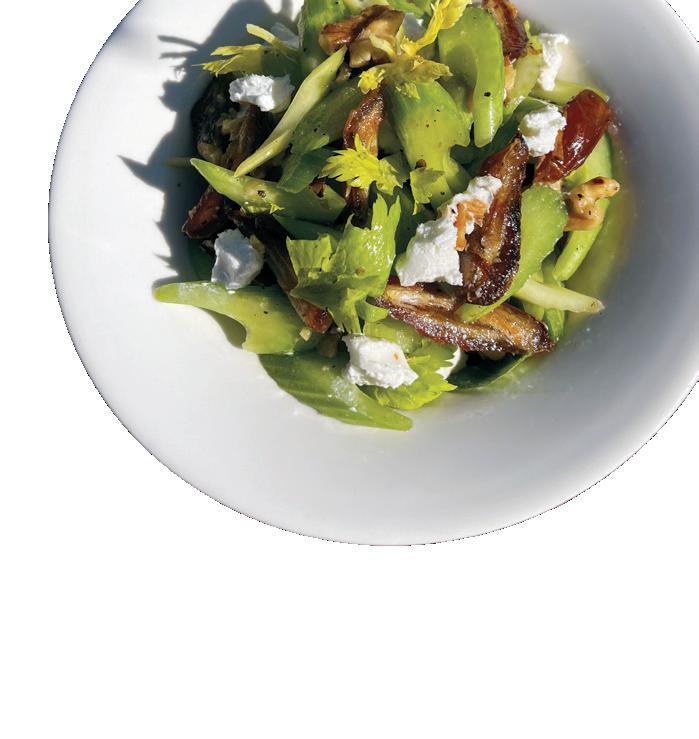
Heat 1 tablespoon of olive oil in a skillet over medium heat. Place the halved dates, cut side down, in the skillet, ensuring they are spaced apart for even caramelization. Without moving them, cook for 2 to 3 minutes, until the cut sides are golden and caramelized.
Flip the dates to the rounded side, season with salt and cook for about 1 minute. Remove the dates from the skillet and let them cool slightly before quartering.
Wipe the skillet clean with a paper towel and return it to medium heat. Add the walnuts to the same pan and toast them for 3 to 4 minutes, stirring occasionally, until fragrant and lightly browned. Remove from heat, let them cool and roughly chop.

Blue Zones Project Monterey County can help you
montereycounty.bluezonesproject.com
In a large bowl, combine the thinly sliced celery and its leaves with the juice from ½ a lemon, the remaining tablespoon of olive oil and a pinch of salt and pepper. Toss gently to coat.
Add the quartered dates and roughly chopped toasted walnuts to the bowl with the celery. Gently toss to combine, ensuring the ingredients are evenly distributed.
Transfer the salad to a serving dish and top with crumbled goat cheese. Garnish with extra celery leaves if desired and serve immediately to maintain the salad’s crisp texture. Serves 4.

collection of industry vets describe why they invest so much in an exhausting craft
STORY BY PATRICE VECCHIONE
PHOTOGRAPHY BY MARK C. ANDERSON
Long before diners walk into their favorite restaurant, the work to prepare their experience begins. Slow-simmering sauces and marinating proteins. Washing and chopping vegetables. Baking bread. Carving filets. Folding napkins. Setting tables. Checking reservations.
Then diners arrive for dinner—and don’t always show up as their best selves.
But the host greets them with a smile.
The server doesn’t hint at the fact her feet are aching because she’s working a double.
The line cook focuses more on rotating eight different temperature-sensitive dishes and sides, on eight different burners, rather than how little sleep he’s had.
All this has been circulating in longtime Santa Cruz restaurant worker Amy Di Chiro’s mind for a while: how a certain type of toil goes unobserved.
How it would prove challenging for a few shifts a week, let alone several decades. How taking a moment to honor that could help complete a picture dominated by flashy chefs and social media.
“If you’ve grown up in the restaurant industry, you know the people who’ve done this work for 30-plus years, and you really want to support them,” she says.
She mentions a co-worker who isn’t quite as quick as she once was, so Di Chiro would help bus a table.
“If I last that long,” she adds, “I hope younger people will do the same for me.”
Di Chiro feels the physical and mental demands of a career that, starting at 16, traversed work as a busser then server then bartender then manager. That has accumulated to the point she’s now studying to become a yogini—while still picking up shifts as a bartender.
Her experience also inspired her to suggest Edible Monterey Bay spotlight some of the lifers who make readers’ favorite restaurants go.
And when she learned I had the same hope to focus on the less-heralded grinders, the day-in/day-outers, who work just as much time as the celebrated chefs with little of the attention, she invited her restaurant peers to nominate worthy workers.
She knows on a personal level what compels hospitality souls to invest in others’ happiness.
“You can change someone’s day,” she says. “They come walking in on a C- day, and we’re going to get you up to a B+.”
But an optimistic attitude doesn’t complete the skill set needed to survive in an industry most every person experiences but only a fraction understand.
Di Chiro lived through a real-time dose of that on her first day serving at Aldo’s Harbor Restaurant, when the manager quit, and Di Chiro had to take over.
“It was the most intense job ever—you’re responsible for everything.” she says. “People text you in the middle of the night about scheduling. If someone can’t come in, you have to fill in the gaps. You sweep the floor, pour iced tea. Burners go out. Dishwashers break. There’s an altercation at the host stand because someone’s pissed that they’ve had to wait too long.
“After a while, I knew that if I could do this, I could do anything!”
But even that empowerment encountered fresh challenges over the past five years. Di Chiro notes menu prices and housing rent rates rising faster than minimum wage, putting multiple layers of pressure on staffers.
“These have been challenging times.,” she says. “It used to be you could pay your $450 rent. But life is hard now [and] COVID’s made a real shift for people—a lot more folks are struggling when they come in and sit down at a table.”
After she sought input on inspiring restaurant lifers on social media, the following five were each recommended—and, as it turns out, happen to work at some of Santa Cruz’s time-honored institutions, a hint at how those spots remain favorites.

“After a while, I knew that if I could do this, I could do anything!”

When still a bar back, Randall Malley says he learned to keep his eyes, ears and memory banks open.
“When you’d hear someone order a drink you didn’t recognize— no cell phones back then—you had to have really good [recall] to make that drink.”
His gift for that provides one peek into how he’s become the beloved and revered bartender he is today—colleagues report they can’t go a shift without a patron asking about Malley—more than 40 years since he began in the craft.
Malley started growing his fan club shortly after the Catalyst moved from its original location to lower Pacific Avenue, when he began as a busser, before moving to bar back, then bartender.

He ultimately tended bar at the Catalyst for 27 years, even as it meant relentless shifts and getting home at 3 or 4 in the morning.
His daughter, Jessica, is a bartender—and a jewelry maker—just like Dad.
“Working at the Catalyst, I don’t know how he did it—it’s intense,” she says. “You’ve got 800 people every night, the artists with all their needs [and] it’s so loud that you have to learn how to read lips, creating lists in your mind 10 things deep to be more efficient.”
“Burners go out. Dishwashers break.
There’s an altercation at the host stand because someone’s pissed that they’ve had to wait too long.”
“Depending on the band playing on a particular night, there would be different drinks asked for, meaning you had to know a lot of drinks,” he says.
This was the mid-80s, when the economy was recessing and his kids had just been born. While his following remembers him for great energy and mixology, he recalls pulling straws to see who would get to work, and taking on a second gig at the Santa Cruz Yacht Club to survive.
While at the Catalyst, Malley also started taking on even more shifts at Olitas Cantina & Grille on the wharf—where he anchors bar service today—on top of work at storied Henflings in Ben Lomond, juggling shifts and job offers, but never needing to fill out an application.
His reputation earned him each opportunity.
“In his whole career,” his daughter says, “I can only think of five days that he’s taken off.”
Malley shrugs and articulates a reality for many in the local industry.
“Just living in Santa Cruz, it’s so expensive,” he says. “It’s hard not to work all the time.”


George Dorian washes dishes at The Crêpe Place up to six nights a week, as he has since 1986.
“I think I’m finally getting the hang of it,” he says, asking if he can keep stacking, scrubbing, rinsing and repeating rather than stop for a portrait.
The quantity of hours, let alone dishes, piled up over what amounts to 300 shifts a year for nearly 40 years, doesn’t seem to faze him.
“If that’s impressive, I don’t know,” he says. “It’s a good place to work.”
What Dorian liked about the job decades ago keeps him there still.
“It’s the people. They trust me to do the job,” he says. “How I do it is up to me. No one’s breathing down my neck.”
Dishwashing isn’t for everyone—but something about it works for a wiry, high-energy guy, who even in conversation prefers not to settle in, staying in motion, shifting his weight from one foot to the other.
“I really enjoy being able to physically move, to keep in shape, and I’ve got a total system dialed in at the back of my mind,” he says.
Routine becomes ritual. Chaos becomes calm.
“I just kind of Zen out,” he says. “I’ve done it like a billion times, but still dishwashing is rewarding. I feel a sense of duty in getting the dishes clean.”
After punching out at 10pm, Dorian has dinner and takes a little nap. Then he turns to his second line of work—as a musician.
“I put down grooves and jazz tracks using a synthesizer and then play guitar over them,” he reports, adding he does this all night long, tucking himself in about 9am.
Last summer, Dorian had his first bout with COVID, and was surprised how much he enjoyed having a block of time away from work to devote to his music.
At 67, he says, “I may just be inclined to give more time to music.”
Liz Baumhefner, a dark-haired woman with a bright smile and buoyant vibe, doesn’t register as a veteran of the restaurant business. After all, she’s 30.
But so much for assumptions. Baumhefner began bussing at Aldo’s as soon as she was able to get a work permit, when she was 14.
“I liked having my own money to buy the things I wanted,” she says.
One could say that not only was Baumhefner, now an experienced server, born into this line of work, but predated that; her mom, Kim Baumhefner, was pregnant with Liz while a server there.
Many Aldo’s patrons see Kim, a light-haired and reserved counterpoint to her daughter, as the face of the restaurant, Liz included.
“People come in and, if they have to, they’ll wait to get a table in my mom’s section,” Liz says.
Part of mom’s magnetism speaks to the art lost on many modern day peers: Kim Baumhefner is a listener who remembers the locals, knows if they want full-strength or decaf, the usual or tend to mix it up.

“I have friends who say, ‘I hate my job’—but I love my job,” Bernardo Ramírez says. “When people say, ‘I love your food,’ I feel happy.”
Cinnamon rolls represent a requirement in Seabright. Ramírez rises at 4am to make that happen.
She also loves the sense of welcomeness people feel at the restaurant, and that she’s a part of helping them feel that way.
“There’s a big community at the [Santa Cruz] Harbor, lots of people to wave at, including dogs and even [pet] donkeys walking by!”
The gig at Aldo’s gains complexity not experienced at most restaurants. After its original home—in a refurbished tackle shop with a wide and always-crowded harborside deck—was destroyed by storms, it relocated to a “pop-up” spot next to the harbor that’s become permanent.
The bustle of each morning includes lugging everything out to transform the space into a restaurant—tables and chairs, condiments, napkins, and then, at the end of the day, break it down, while the sea air does nothing good for the computers, and occasional winds whip menus and napkins around.
“You’ve gotta wear a hat, but I love being outdoors, and I’m not sitting at a desk all day,” Kim says. “It’s not a bad office, that’s for sure!”
That unique setting, combined with popular breakfasts, house-made Italian “fugasa” bread and signature fried calamari— and staff that feels, appropriately enough, like family—make Aldo’s an institution.
When asked what it’s like working as mother and daughter, the two women look at each other, raise their eyebrows and laugh.
With a twinkle in her eye, Kim says, “If someone comes in who I don’t like, I send them to Liz’s section!”
Liz laughs, then adds, “We get to see each other more than we otherwise would. Really, we have each other’s backs.”
Given the chance to put his feet up, Bernardo Ramírez, Linda’s Seabreeze Cafe head chef and kitchen manager, would rather not.
“Mostly, I work all the time,” he says. “When the restaurant closes for a few
days, like over Christmas, I get bored. My wife says, ‘Take a rest.’ I say, ‘No, I’m going outside to sweep.’”
Most of us, given the chance, would pull up a chair, but this guy is a doer. He likes to be useful, to make things better than they were.
Ramírez, who’s worked at Linda’s Seabreeze since Reagan was president, is a man whose zest for life comes through not only his work, but it’s also in his brown eyes, wide mustached smile, the lilt of his voice.
Within his sense of purpose and joy is his secret to life: “Everything you do, you have to do with love, and that makes it easy.”
The everything Ramírez does includes not only preparing breakfast and lunch at Linda’s Seabreeze, but working as a butcher at Shopper’s Corner, and managing the apartment complex where he’s lived since the mid-1980s.
“I love routine,” he says, but notes another aspect of his motivation. “Every day, I learn something different.”
“At Linda’s I work in the back, so mostly, I talk to my coworkers, people I see every day, but at Shopper’s, I work with the customers. Some are really nice,” Ramírez says, and delicately adds, “Others are more particular.”
Whatever energy he encounters, he strives to give them exactly what they ask for.
“My motto is to keep everyone happy,” he says. “Then they’ll come back.”
Ramírez pauses a moment, and looks into the distance before continuing.
“Sure, we sometimes have difficult days,” he says, “but when I go to my jobs, I don’t take my problems with me.”
Monterey writer and artist Patrice Vecchione’s latest books are Ink Knows No Borders: Poems of the Immigration and Refugee Experience and My Shouting, Shattered, Whispering Voice: A Guide to Writing Poetry & Speaking Your Truth.
Mark C. Anderson contributed to this report.



Unforgettable
Serve
Aged even more Aged
Made with care
Crafted in Spain
In a world that often prioritizes speed over substance, there remains proof that good things, and excellent taste, take time. D.O. Cava and Jamón ConsorcioSerrano are two such treasures, each representing a unique blend of Spanish tradition and taste created with time and perfected over centuries.
Cava has earned its place among the world’s finest sparkling wines, yet it remains wonderfully versatile. Whether paired with a simple salad, a casual meal or a celebratory toast, Cava brings a touch of elegance to every occasion. What makes Cava de Guarda Superior unique is that it is produced using the traditional method where secondary fermentation occurs in the bottle.
This meticulous process, lasting a minimum of 18 months, is carefully overseen by the D.O. Cava regulatory body, ensuring that each bottle upholds the highest standards of quality and authenticity. Made from organic vineyards that are over 10 years old, Cava de Guarda Superior reveals its craftsmanship with every pour. As the delicate, harmonious bubbles rise to the surface, you can truly appreciate the time and care it took to perfect them!
Similarly, Jamón ConsorcioSerrano is more than just a drycured ham. This exquisite product is made using traditional curing

methods which takes a minimum of 12 months to deliver a delicate and rich flavor. Each production is upheld to the rigorous standards of the Consorcio del Jamón Serrano Español, which ensures that every piece of Jamón ConsorcioSerrano bearing the seal is of exceptional quality. Like Cava, Jamón ConsorcioSerrano is not merely an accompaniment to festive tables; it is a versatile delight that can elevate everyday meals with its complex flavors and delicate texture.
Both Cava and Jamón ConsorcioSerrano are perfect examples of how time-honored craftsmanship, underpinned by the European Union’s commitment to quality and tradition, creates products that are unmatched in their category. They are not just crafted in Spain; they are perfected by time, offering a taste of excellence that is both accessible and extraordinary. Whether enjoyed on a special occasion or as part of your daily life, Cava and Jamón ConsorcioSerrano bring the best of Europe to your table.

Learn more on our website

New and familiar dishes and drinks bring a once exotic fruit to our table
PHOTOGRAPHY
BY
The tastes we remember from childhood speak gently to our similarities and differences.
Nostalgic memories might begin with pasta, peanut butter, pancakes, or—if you grew up in Mexico like me—there was always sour, sugary and spicy tamarind.
The joy of its discovery came with finding chile-covered tamarind candies among the treasures of a piñata, gliding with friends through endless conversations paired with bites of that tasty brown mass and sticky fingers that relay a sense of belonging.
It might also have been the thrill of freedom and adventure rushing out to the corner shop to enjoy that familiar taste.
Maybe it is the feelings we associate with those flavors that keep us returning. All those “grown up” spins on childhood favorites have a strong reason to exist.

BY ANALUISA BÉJAR
PATRICK TREGENZA
How a member of the leguminous family that originated in Africa ended up in some of our stories is due to centuries of exchange, getting to know each other better and sharing what our childhood tasted like.
Tamarind trees thrive in warm humid climates and are often grown for beauty as much as their fruit. Their name of Arab origin, means Indian date, probably because of its flavor and it being part of trade first along the Pacific and Indian oceans, and later, the Atlantic.
The fruit presents like a thick fava bean pod which, when mature, hardens a thin crust with a woody appearance that looks just beautiful piled up in markets.
Inside, a few long fibers hold together sticky brown pulp that surrounds its seeds.
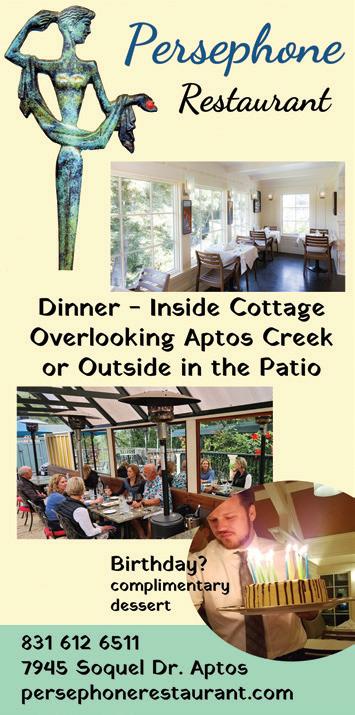



Its flavor could be described as a mostly tangy mix of date, apricot and lime. The delicately shaped flowers the tree produces, yellowish with orange or red streaks, are edible too, as are the sour and tender new leaves, which can be pickled.
In Southeast Asia, tamarind is often added to enrich soups, and is a great booster for any seafood or poultry-based broth. It is also the protagonist of the flavor profile of pad Thai, and many other noodle and rice dishes.
After tamarind came from Asia to the Americas, it has been used mostly in drinks, and—in Mexico, Brazil and many Caribbean and other Latin American countries—to make candies by combining the pulp with sugar, salt and sometimes chile in a thick mass meant to be shared.
It is also used in frozen pops and sorbets. In Mexico, it has found new expression in recent decades by being incorporated into moles and savory sauces.
Back in its African homeland, tamarind is generally cooked as part of curries and sauces, and paired with rich meats like lamb and goat, because unlike citrus, even if simmered long, it won’t lose its sour notes. In India it is widely combined into stews, pickles, rice dishes and chutneys.
Tamarind is also present in Jewish cuisine, particularly in chicken, salad and ground meat dishes. And yes, it is one of the main ingredients in Worcestershire sauce.
When it comes to applying it in your home kitchen, there’s no need to complicate things. All you need is to add a tablespoon of tamarind purée to elevate any dish or drink.
Combine it with soy sauce for seared tuna or salmon, or anywhere you would use teriyaki.
Mix it with maple syrup for an outstanding glaze for fish, chicken or shrimp. Glaze carrots, cauliflower or rice with tamarind and butter.
Use it in your salads anywhere where vinegar or citrus would be.
It does absolute wonders for rich meats like duck or pork, particularly belly or bacon, or complex flavors like hearty mushrooms and beef stews.
Tamarind combines very well with chile of course, but also mango, citrus, pineapple, ginger, and even milk or white chocolate. In the cocktail world it offers infinite possibilities. It’s all about playing and having fun with it.
Finally, a few notes on how to extract tamarind pulp.
Break the outer woody shell and pull the stem that holds the long fibers, place pods in a stainless steel or enamelware container. Boil enough water to cover them and let stand for 30 minutes. If pods are older and drier, you might need to simmer them for a few minutes.
Stirring with a spoon, separate the pulp from the seeds. Sieve the pulp, pushing the seeds with a spatula through a strainer to get the most out of them, and reserve. You may also use a food mill strainer, especially when working with larger quantities.
If you’d like to sweeten the purée, a good ratio is about 4 tablespoons of sugar per cup of pulp and adjust to taste. You can fine-tune the consistency by adding water or simmering to thicken, depending on the use.
Refrigerated fresh tamarind purée lasts about a week, but it freezes well.
Pods as well as tamarind paste are sold in southeast Asian markets. Sometimes the paste has seeds, just combine it with hot water and strain before using. It is also sold jarred without seeds, making it very accessible for a quick improvement on any dish. Latin American markets sell pods yearround and a sugary concentrate for aguas frescas, or cocktails. Just read the label to ensure the main ingredient is tamarind pulp.
Analuisa Béjar loves exploring flavor as the chef at her Sunny Bakery Cafe in Carmel Valley. A native of Mexico City, she’s gone on to become an award-winning writer, editor, food critic, recipe developer and culinary teacher.
The stock base gives this delicious sauce an extra layer of flavor and sophistication, it freezes well, and it is a wonderful complement to seafood. The jicama salad offers an interesting temperature and texture contrast, perfect for a warm day.
For the shrimp and sauce
30 large head-on shrimp
3 tablespoons butter
2 sticks celery, sliced
1 carrot, sliced
1 onion, diced
2 sprigs thyme
10 sprigs cilantro, leaves separated from stalks
1 tomato, diced
3 cups water
½ cup tamarind purée (if using unsweetened, add 2 tablespoons sugar or to taste, see article, p. 45)
1 teaspoon chiles chipotles in adobo
¼ cup olive oil
Salt and pepper
Peel and devein the shrimp, keeping the tail on. Reserve raw shrimp, refrigerated, until ready to serve.
Warm the butter in a heavy bottomed pot and add the shrimp heads and shells. Sauté for 3 minutes. Add the celery, carrot, onion, thyme and cilantro stalks. Cook, stirring for 3 minutes. Add the tomato and water.
Simmer over medium-low heat for 20 minutes. Strain, pressing on the solids, and reserve the liquid; you should have about 1 cup. Boil to reduce it if necessary.
Add the tamarind purée, and chipotle to taste. Adjust seasoning with salt, simmer until slightly thickened and reserve.
When ready to serve, warm the olive oil, season shrimp with salt and pepper and sauté in a pan or grill until cooked.

For the jicama salad
1/3 cup olive oil
¼ cup grapefruit juice
2 cups jicama, cut into batons (large sticks)
2 Persian cucumbers, thinly sliced lengthwise
2 red grapefruits, cut into sections
Salt and pepper
Combine olive oil and grapefruit juice. Season to taste. Add jicama and marinate while cooking shrimp. Mix in cucumber and grapefruit.
Serve salad with shrimp, decorate with cilantro leaves, add a few tablespoons of tamarind sauce and serve additional sauce on the side. Serves 4.


Mezcalita is the newest addition to the Margarita family. It is made with mezcal instead of tequila. The result is smoky and bold, perfect for tamarind’s sour notes. The spicy rim is indispensable for the complete effect.
2 shots mezcal, preferably Artesanal Espadín Joven type
1 shot tamarind purée, sweetened (see article)
¾ shot Cointreau or another orange liquor
½ shot lime juice
Tajín chile powder and lime for the glass rim
Fresh oregano, for serving Jalapeños, sliced, for serving Ice
Fill shaker with ice. Add mezcal, tamarind, Cointreau and lime. Shake vigorously.
Push a lime wedge through the rim and a part of the side of the glasses. Cover with Tajín and fill with ice.
Strain mezcalita over ice. Decorate with oregano and jalapeño. Serves 2.








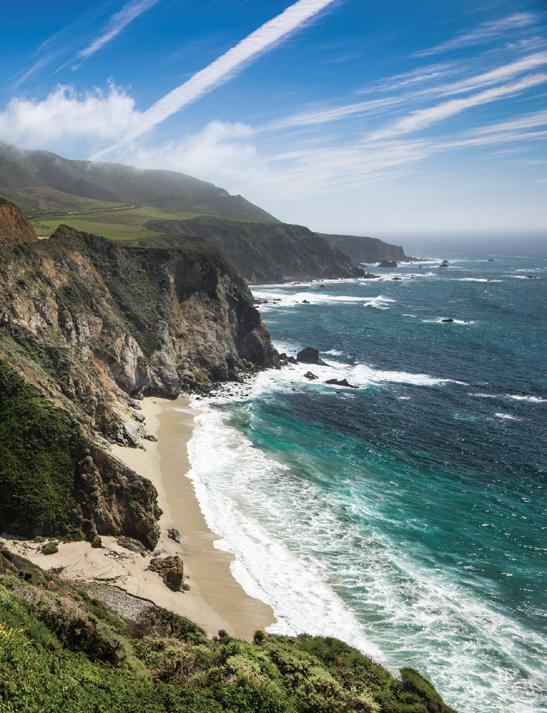

Russell Joyce ushers in an inspiring era in the beloved barn at Ventana Vineyards
STORY BY LAURA NESS
PHOTOGRAPHY BY MARK C. ANDERSON
In a windswept, rock-filled vineyard, a few miles from the Soledad Mission, on Los Coches Road, stands a barn that was once the home of Ventana Vineyards.
Originally built by Doug Meador—a Navy pilot who flew in Vietnam, and a legend in these parts for his abundant personality and groundbreaking developments in viticulture— the barn housed a makeshift winery.
It was also a gathering place for the wine families of the region.
Russell Joyce, now 38, is a young man with an old soul. He freely admits that one of the reasons he bought the dilapidated Ventana property in February of 2021, after three years of negotiating, was nostalgia.
He remembers his parents dancing in the barn and drinking Chardonnay with their friends, long before his father cultivated a 5-acre vineyard of his own, and opened a tasting room in the village.
“I wanted to bring back that sense of community, that sense of family, that I felt so strongly in the wine business back then,” he says. “I wanted to create a space where people can come together and celebrate all that makes wine so fundamental to our county.”
Plus, there were other reasons, he adds: “I also love the rural setting here, and that sense of being out in the terroir.”

“I like to be as delicate as possible with the fruit,” Russell Joyce says. “Subtle is good.”



Agriculture tends to be a generational business. Joyce is a prime example.
“My father basically handed me the business with no training,” he says. “I was on my own. You don’t wake up as a master chef. It basically took me 10 years to figure out my path.”
By that time, he was feeling constrained at the facility in Salinas where he was making wine. More importantly, he says, “A winemaker wants to be in the vineyard and cellar, looking out at the land.”
Many spend their lives making wine, but never a buck. He didn’t want to be among them.
“I wanted to be in charge of my own destiny, and to create a legacy,” he says. “I also wanted to have a winery that wasn’t a burden on my family and kids.”

In 2019, he saw an opportunity to acquire the Ventana property that Meador had sold in 2006 to a group of investors, despite its cracks.
“It was unbearable,” says Joyce of the barn’s dilapidated state. “How did they make wine? Is it safe to drink?! I do a lot of unfined and unfiltered, and I am big on cleanliness, and all I could think was, ‘OMG, what were they doing?!’”
Lacking the finances to bring in a con-
tractor to do the $2 million upgrade, he got a loan from 1st Capital Bank in Salinas.
“I leveraged my house,” Joyce says. He cowboyed it, employing friends who are contractors, even inviting his uncle from Hawaii to help, fresh off retirement as a fire captain, the same elder who taught him to fish and scuba dive.
“I’m really close to my uncle,” says Joyce. “He needed a change, and said, ‘Feed me well and give me good wine!’”
The gig involved seven days a week, starting at 6am. His uncle spent those three months living with Joyce, his wife Charlotte, their newborn and 3-year-old son. It was hectic.
“The job really took a toll on my body!” Joyce says. “But it was extremely rewarding and it felt like we were doing something really good.”
To see the place entirely rebuilt and up to code, complete with modern winemaking conveniences, like proper cooling and glycol on the tanks, is to have a small sense of appreciation for the Herculean effort involved.

“I wanted to bring back that sense of community, that sense of family, that I felt so strongly in the wine business back then.”

The beautiful rock wall that fronts the property tips off the labor involved in clearing the land, and at what makes Arroyo Seco wines special.
Neighbor and grower Michael Griva appreciates Joyce’s commitment to Arroyo Seco.
“His feet are firmly planted in the AVA, and we know he and his children will be great stewards for years to come,” says Griva. “In Russell’s wines, the land is the main ‘voice’ in the bottle.”
Besides the legacy-building component
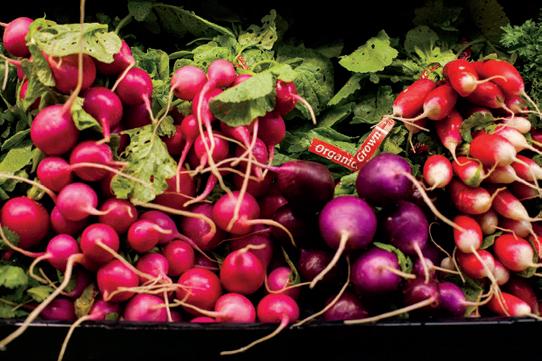

of the project, Joyce also saw the potential for expansion.
The property not only came with warehousing, a winery and a vineyard all in one place, but it also came with an unlimited bond, which essentially allows you to make as much wine as you want, which is not available in California anymore.
He’s leasing out space to other winemakers, including Will Chesebro, and doing custom crush contracting as well.
“I want more cool and dedicated winemakers to make wines from here,” Joyce says. “I want to foster that creativity by creating a space for cooperation.”
For the first time in his career, he’s not dragging in fruit from all over.
“I decided to choose one AVA, keep my reach small, and reduce my stress level,” he says. “Everything comes from within a 5-mile radius, except for the Carmel Valley fruit.”
Will Chesebro is one of the beneficiaries of Joyce’s setup.
“The dirty little secret of the wine industry is the utter unsustainability of hauling fruit,” Chesebro says. “Being able to process my Cedar Lane fruit right here in Arroyo Seco means fresher, better wines. It’s a win-win.”
Russell’s Joyce wines are all from the Arroyo Seco AVA, including the original Ventana, Guidotti, Mission Ranch, Roger Rose and Cedar Lane vineyards.



a week • 9am - 9pm


The wines, including albarino, Gamay and syrah, are light in tannin and low in alcohol, mostly 12% ABV and below.
“These wines are transparent, a true reflection of terroir,” he says. “We channel the rocks into the wine.”
Michael Kohne, co-owner of Crave Wine Bar & Shop in Hollister, is a founding board member of the Arroyo Seco Winegrowers. He notes Joyce’s renown as a winemaker is well-established, and carries Joyce’s
Noah Joyce isn’t the only one who loves coming to Joyce’s barn winery. It’s also his dad’s happy place, and where everything from staff barbecues to the March 28 spring release party—open to the public—keeps the community stoked to show up.
Joyce makes 20,000 cases a year, which presents a lot of work for himself and his three employees.
But the wines are resonating in the marketplace. “Arroyo Seco has energy and charm, along with that little taste of California sunshine,” he says, “coupled with the freshness on the palate from the rocky soils and the constant wind.”
He eschews what he calls “leesy cheesy oaky” wines, pretty much the definition of California Chardonnay.
Chesebro observes Joyce’s youthful energy and drive impacting the wider growing area.
“Russell’s high quality artisanal wines and savvy marketing sense have been key in boosting the visibility of the Arroyo Seco AVA,” Chesebro says.
Beyond Arroyo Seco, but within Monterey County, the Russell Joyce label includes vineyard designates from Chalone, the Santa Lucia Highlands (Escolle and Cortada Alta) and the Carmel Coast (Albatross Ridge and Pelio).
Despite the constant temptations to make sexy new varieties from exotic vineyards, he’s staying as focused as his wines.
“I don’t want to be a jack of all trades and master of none,” he says. “I’m doubling down on what I am good at. I need more peace and tranquility in my life.”
That already involves recreating the barn-party days of old, with families chowing down on barbecue from the Santa Maria grill next to the welcoming picnic lawns, reveling in the music, laughing with abandon and dancing up a storm.
And while the wine will be freely flowing, it will not be oaky Chardonnay.

Laura Ness is an award-winning journalist, who writes about wine, food and travel for a variety of publications on the Central Coast and beyond.

Photos by Jim Sullivan
by Drew Deckman
Back from the brink of extinction, the Pacific bluefin tuna population is rebounding at an impressive pace. A strong, global management plan will ensure its long-term survival.
From my years spent cooking across Europe to my turn as a cocinero in Baja, Mexico, to my newest restaurant in San Diego, I’ve always served up the freshest local ingredients I can find. No matter what I’m cooking, I focus on the ingredients, not fancy techniques. When it comes to seafood, I opt for items that not only taste great but also promote the longterm health of our fisheries, our local fishing economy, and our ocean. Striking that balance isn’t always easy – especially when doing what’s best for the planet means avoiding popular seafood dishes.
For years, I left Pacific bluefin tuna – arguably the tastiest fish in the sea – off the menu due to severe overfishing by commercial fishing fleets from around the Pacific. By 2010, the stock had been depleted by 98 percent from historic levels. Fear of serving up one of the last Pacific bluefin tuna made it easy to take a pass.
But there’s good news: Pacific bluefin tuna is making a comeback. The science and management have improved such that last fall Monterey Bay Aquarium’s Seafood Watch – the gold
standard for chefs and consumers who want to source and eat seafood fished or farmed in ways that don’t harm the environment – upgraded some of its Pacific bluefin tuna recommendations from red (avoid) to yellow (a good alternative). In the 25 years Seafood Watch has been rating seafood, that’s a first.
What changed? In an unprecedented show of global cooperation, representatives of the Pacific nations that oversee Pacific bluefin set fishing quotas and an ambitious rebuilding target. The tuna fishing industry – including U.S. commercial and recreational fleets –followed the plan and reduced their catch. According to the latest stock assessments, the population size of Pacific bluefin tuna reached the initial recovery target more than a decade ahead of schedule.
So, where does that leave chefs who are grappling with whether to serve this delicacy? It’s not a decision I made lightly, but as we await the start of Pacific bluefin tuna season here in Southern California, I’m dreaming up new recipes and making plans to integrate
locally sourced Pacific bluefin tuna into my menu. But don’t expect to find a Pacific bluefin tuna steak offered up as a main course. As the yellow rating suggests, we need to go slow and start with just a taste.
This amazing creature’s return is not only a win for tuna lovers and ocean conservationists alike, it’s also a win for local fishermen who want to do right by the fish but need to make a living. Again, it’s all about finding the balance between the long-term health of our fisheries, our local fishing economy, and our ocean.
There’s more work to do to get Pacific bluefin tuna to a Seafood Watch green – best choice – rating. The Pacific nations – including the United States – must put a plan in place that assures the long-term health of the fishery. I’ll be watching what comes next and will pull Pacific bluefin off the menu at the first sign of trouble. But I’m hopeful the momentum we’ve seen to date will get us to a place that lets me keep serving Pacific bluefin tuna – and ultimately gets it to green.

Deckman is a Michelin star chef on a mission to revolutionize sustainable food culture by committing to zero waste and prioritizing sustainable sourcing. In addition to establishing multiple restaurants in Baja, Mexico, he recently opened 31ThirtyOne in San Diego’s North Park neighborhood. Serving only locally sourced ingredients, he donates 1% of monthly revenue to help farmers implement carbon farming projects. Deckman is a member of Monterey Bay Aquarium’s Blue Ribbon Task Force.







All natural pork, beef and lamb raised sustainably and humanely by a community of more than 600 independent family farmers and ranchers to produce the highest quality meat.


100% Certified Humane ®
No antibiotics or added hormones—EVER
No crates—EVER
Raised outdoors and in deeply bedded pens
100% vegetarian feeds





A pantry staple gets a supercharge from seasonal ingredients and creativity, times three
BY AMBER TURPIN
PHOTOGRAPHY BY GENEVA RICO
The association of granola and hippies may never fade. Which is fine, as it’s not really hurting anybody to align the two things in our social consciousness.
But did you know that granola was invented way before bell bottoms and peace signs?
Or that the concoction—more similar to GrapeNuts, and originally called “granula”—was invented in 1863 by a doctor at a popular health spa in Dansville, N.Y.?
Subsequent versions were named “granola” to avoid legal issues. The 1960s saw a revival of the cereal, with the addition of other ingredients like nuts, fruits and seeds, in tandem with the hippie movement that was taking place at that time.
Hence, our crunchy granola labels that remain to this day.
The irony is that many of the options found at a grocery store are essentially smashed up cookies, loaded with sugar and other processed ingredients.
We still think of granola as healthy, but there are certainly varieties out there that could fall into the treat category.





Granola is one of those staples that is super easy to mix up in your kitchen, and way more cost effective.
To have ultimate knowledge of which kind you are getting, just make a batch at home.
Granola is one of those staples that is super easy to mix up in your kitchen, and way more cost effective.
Plus, you get to have the added fun and flexibility to create flavor variations and ones you won’t usually find in the store.
The three recipes below take a cue from the spring, playing with fruity and flowery ingredients to add a bit of whimsy to your breakfast (or dessert) bowl. I workshopped these recipes by leaning on a granola formula I’ve relied on for years, and then taking inspiration from the season to spark a bit of excitement beyond the typical oat-nut-dried fruit combo.
The trio also offers a range for your dietary needs and preferences, from a decadent, butter-based version (this would be closest to the cookie kind) to another that is completely grain free.
Check out the tips and tricks section (p. 63) as well, and know that making granola can and should be fun and easy, with swapping out of ingredients encouraged if you don’t have something on hand.
So crunch away, you hippies!
Amber Turpin is a freelance food and travel writer based in the Santa Cruz Mountains. She is also a field coordinator for the Slow Wine Guide USA and story editor for Edible Silicon Valley.





4½ cups rolled oats
1 cup raw walnut halves or pieces, coarsely chopped
½ teaspoon salt
½ cup dried petals, chopped and divided
½ cup unsalted butter
½ cup honey
¾ teaspoon rose water
½ cup cocoa nibs
Preheat the oven to 300° F.
Melt the butter in a small saucepan over low heat, keeping a close watch on the pan and stirring frequently to avoid browning. Remove from heat and whisk in the honey and rose water.
1/3 cup cold-pressed virgin coconut oil
1/3 cup coconut sugar
1 teaspoon vanilla
¾ teaspoon salt
2 cups large coconut flakes
1 cup raw pecans, chopped
1 cup sliced or slivered almonds
1 cup raw sunflower seeds
1 cup raw pumpkin seeds
3 tablespoons chia seeds
Zest of 1 small lemon
Preheat the oven to 300° F.
Melt the coconut oil in a small saucepan over low heat. Keep an eye on the pan because the oil will melt quickly and you don’t want it to get too hot. Remove from heat and whisk in the coconut sugar, vanilla and salt.
Place the oats, walnuts, salt and ½ of the dried rose petals in a large bowl and mix to combine. Pour in the wet ingredients and stir well to coat completely. Transfer the mixture to a parchment paper-lined baking sheet, spreading evenly to avoid burning on the edges and place in the preheated oven.
Bake granola for 30–35 minutes. After 15 minutes, stir and add the cocoa nibs. Then stir every few minutes until golden.
Remove the granola from the oven, let it cool completely and store for up to a month at room temperature in an airtight container, such as a large glass jar with a tight-fitting lid. Makes about 6 cups
Place the coconut, nuts and seeds in a large bowl and mix to combine. Pour in the wet ingredients and stir well to coat. Transfer the mixture to a parchment paper-lined baking sheet, spreading evenly to avoid burning on the edges and place in the preheated oven.
Bake granola for 30–35 minutes. After 15 minutes, stir once and add the lemon zest. Then stir every few minutes until golden.
Remove the granola from the oven, let it cool completely and store for up to a month at room temperature in an airtight container, such as a large glass jar with a tight-fitting lid. Makes about 6 cups




















1⁄3 cup tahini
1⁄3 cup maple syrup
¾ teaspoon salt
4 cups rolled oats
1 cup raw almonds, chopped
½ cup raw sesame seeds
¼ teaspoon freshly ground pink peppercorns (optional)
2⁄3 cup freeze-dried berries, chopped
Preheat the oven to 300° F.
In a small bowl, combine the tahini and maple syrup and salt.
Place the oats, almonds, sesame seeds and pepper (if using) in a large bowl and mix to combine. Pour in the wet ingredients and stir well to coat completely. Transfer the mixture to a parchment paper-lined baking sheet, spreading evenly to avoid burning on the edges and place in the preheated oven.
Bake granola for 30–35 minutes. After 15 minutes, stir once and add the freeze-dried berries. Then stir every few minutes until golden.
Remove the granola from the oven, let it cool completely and store for up to a month at room temperature in an airtight container, such as a large glass jar with a tight- tting lid. Makes about 6 cups.
For max avor and exibility
•You can use these recipes as blueprints and substitute nuts, seeds, fruit, fats and sweeteners as you have on hand, just make sure the proportions are the same for dry and wet ingredients.
•Always use raw nuts and seeds as opposed to roasted, since the baking process in the granola will toast them plenty.
•Taste the seeds before using, especially sesame seeds, as just one rancid one can ruin your whole batch of granola.
• Always line the baking sheet with parchment paper or a silpat mat to avoid burning on the bottom.
•Stirring in the more fragile ingredients (like dried fruit, ower petals and citrus zest) halfway through baking will avoid burning.
•It is a good idea to rotate the baking pan, top to bottom as well as 180 degrees, to ensure even baking.
•Once you remove the granola from the oven, press down with a spatula or spoon to create more clumps once cool.
• Always cool the granola completely before storing to make sure it stays crisp.
•A great source for dried rose petals is Mariquita Farm in Watsonville.
•Trader Joe’s carries an organic, freeze-dried berry mix that is perfect for the berry granola.



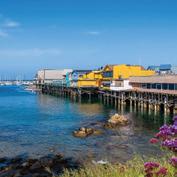


































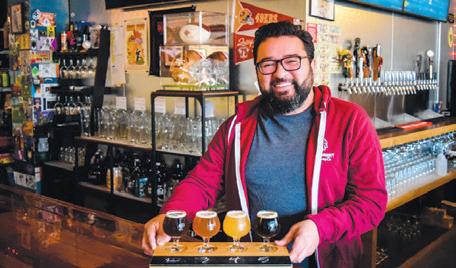











All of these restaurants emphasize local ingredients and they also advertise in Edible Monterey Bay! Please check hours online before you go and tell them we sent you.


Cavalletta 9067 Soquel Drive
831-661-5010 • cavallettarestaurant.com
Chef-owners Shawn Ryberg and Nick Sherman (who also operate Trestles in Aptos) offer seasonal Italianinspired fare in a laid back environment that includes a leafy deck overlooking Aptos Creek. Pizzas, salads, pastas and entrées are all made in-house using locally sourced ingredients. Short rib rigatoni, seafood scampi, focaccia with burrata and lasagna, served Mondays only, are fan favorites. The partners spent nearly a year perfecting their pizza dough, which is light and tangy, and blisters to perfection in the wood-fired oven. Open Th–F, M 5–9pm. Sa–Su 4:30–9pm.
Mentone
174 Aptos Village Way
831.708.4040 • mentonerestaurant.com
A fun twist on the cuisine of the Riviera, Mentone is a casual restaurant and cocktail bar from David Kinch— one of the country’s most acclaimed fine dining chefs. Kinch loves the Mediterranean coast where France meets Italy, and Mentone brings some of those flavors to California with appetizers like duck rillettes and stracciatella with olive oil produced just down the road. There are house-made pastas and a handful of bistro-style entrées like pan-roasted black cod and steak frites, but the main draw is pizza—pulled bubbling hot from the Valoriani wood-fired oven and loaded with Italian toppings. Open W–Su 5–9pm. Lunch Sa–Su noon–2:30pm.

Persephone
7945 Soquel Drive
831.612.6511 • persephonerestaurant.com
With a namesake like the mythic Persephone, this restaurant in Aptos proclaims its deep reverence for seasonal cooking. Themes central to harvest, winter and spring are core to Persephone’s story, and are reflected in the changing menu at this fine dining destination, where chef Cori Goudge-Ayer presents inventive, ingredient-driven creations. The restaurant is a family-run passion project, bringing together parents, siblings and a long history of culinary arts in a beautifully redesigned



space overlooking Aptos Creek. Open for dinner W–Sa 5–8:30pm. Fourth Sundays, Winemaker Dinner with five-course pairing menu.
New Leaf Community Markets
161 Aptos Village Way
831.685.8500 • newleaf.com
The Aptos branch of the beloved local market group occupies the remodeled Hihn Apple Barn, built in 1891. In addition to local groceries and organic produce, New Leaf Aptos has made-to-order sandwiches, pizza, freshly rolled sushi, soup and hand-prepped salads, as well as a coffee bar, juice and smoothie bar and organic Straus soft serve ice cream. Open daily 8am–9pm.
The Penny Ice Creamery
141 Aptos Village Way, Suite 2
831.204.2523 • thepennyicecreamery.com
Open Su–Th noon–9pm, F–Sa noon–10pm. See The Penny description under Santa Cruz for more.
Seascape Foods
16B Seascape Village • 831.685.3134
A charming family-owned market with an ample deli counter featuring daily chef specials, salads, breakfast items, freshly squeezed juices and sandwiches on housemade organic sourdough bread. The grocery section includes organic produce, artisanal products, local beer and wine, and gifts. Eat outside next to the fountain on the patio or take your goodies to the beach nearby. Open daily 8am–8pm.

Big Sur River Inn Restaurant & General Store
46800 Highway 1
831.667.2700 • bigsurriverinn.com
The River Inn opened in 1934, selling homesteader apple pies to locals and travelers. The small family business is known as “the place with the chairs in the river.” Food and drinks are all made from scratch. Enjoy your meal under the redwoods with a view of Big Sur River or with your feet in the water. Visit the Burrito Bar for tasty graband-go fare to fuel your Big Sur adventures. Open daily 8am–8pm.
ediblemontereybay.com


Capitola Wine Bar and Merchants
115 San Jose Avenue
831.476.2282 • capitolawinebar.com
Where the wines meet the waves, Capitola Wine Bar can be found in the seaside village of Capitola and offers small batch wines hand selected by its team of certified sommeliers. Wines from all over the world are available, by the glass, bottle or flight, along with local beers and a great kitchen. The menu includes charcuterie plates, salads, flatbreads and desserts, as well as Doug’s “Cup of Mac.” Events are always happening like Live Music, Paint Nights, Trivia Nights, Wine Blending and more. Don’t miss the dog-friendly patio and the $7 happy hour W–F 5–7pm. Open W–Su. For more information see website.
Gayle’s Bakery & Rosticceria
504 Bay Avenue
831.462.1200 • gaylesbakery.com
A favorite with locals and a must-stop destination for visitors since 1978, Gayle’s Bakery offers freshly baked breads, pastries, cookies and cakes every day of the week. The rosticceria is famous for its soups, salads, sandwiches and rotating Blue Plate Dinners, which are served hot and also available from the grab-and-go case to reheat at home. A dining patio with a fireplace and occasional live music make Gayle’s a community gathering place as well. Open daily 6:30am–7:30pm.



New Leaf Community Markets
1475 41st Avenue
831.479.7987 • newleaf.com
Just opened in November, the new Capitola New Leaf Community Market occupies a larger footprint at 24,000 square feet, allowing expanded sections for organic produce, meat and seafood. The store also has increased its natural wellness section and its hot and cold food to go options. Enjoy California BBQ, fresh sushi and a self-serve poke bar. A coffee and juice bar offers locally roasted drip coffee and juices in reusable glass bottles. Open daily 7am–10pm.
The Penny Ice Creamery
820 41st Avenue
831.204.2523 • thepennyicecreamery.com
Open Su–Th noon–10pm, F–Sa noon–11pm. See The Penny description under Santa Cruz for more.
Trestles
316 Capitola Avenue
831.854.2728 • trestlesrestaurant.com
Just steps away from the iconic Capitola train trestle, chef-owner Nick Sherman’s passion for great food is evident in every dish at his popular neighborhood bistro. Local seasonal ingredients star in appetizers like chicory salad, roasted fairytale pumpkin with goat cheese and mole negro, Brentwood street corn and crispy pork belly with watermelon radish. Entrées include smoked eggplant gnocchi, Niman Ranch pork chop and fresh fish— all served with local wines and craft beers on tap. Open W–F 5–9:30pm, Sa–Su 4:30–9:30pm.

Covey Grill
8205 Valley Greens Drive
831.620.8860 • quaillodge.com/dining/coveygrill
Covey Grill at Quail Lodge features USDA steaks and sustainably sourced seafood complimented by unique plantbased offerings in addition to seasonal American cuisine. Covey Grill offers casually elegant indoor and outdoor dining options against the stunning backdrop of Quail’s sparkling lake and lush garden landscapes. Open for full dinner service Mon–Sun 5–9pm, with bar opening at 4pm.

Earthbound Farm’s Farm Stand
7250 Carmel Valley Road
831.625.6219 • earthboundfarm.com
Earthbound Farm’s 100% certified organic kitchen delights with specialty coffee and tea, soft serve ice cream and a made to order breakfast and lunch menu—including soups, sandwiches, salads, baked goods, fresh juices and smoothies. Food is available to be enjoyed on the beautiful grounds or for takeaway. In addition to certified organic produce, the Farm Stand offers a selection of natural, organic, local beer and wine, groceries, gifts and flowers. Stroll through the gardens and learn about Earthbound’s commitment to organic integrity. Open daily, but check hours online as they change seasonally.
Grasing’s
6th Avenue and Mission 831.624.6562 • grasings.com
Chef-proprietor Kurt Grasing’s namesake restaurant has expanded since opening in 1998 to include two large dining rooms, multiple outdoor dining areas and the ever-popular bar/lounge. A Carmel classic located in the heart of the village, Grasing’s serves California cuisine, with an award-winning wine list and a vintage spirits program featuring classic cocktails made with rare Mad Men-era gins, whiskeys, Camparis and amaros. Open daily M–F 11am–9pm, Sa–Su 10:30am–9pm.

Sea Harvest Fish Market & Restaurant
100 Crossroads Boulevard, Suite A 831.626.3626 • seaharvestfishmarketandrestaurant.com
The Deyerle family that owns this local gem has its own fishing boats for the freshest catch on the Monterey Peninsula. Sea Harvest doubles as a fish market and casual restaurant with indoor and outdoor seating. The oysters and clam chowder are customer favorites, but don’t miss the fried combo platter, grilled fillets and fish tacos. Open daily 8am–8pm.
Stationaery
San Carlos Square, Between 5th and 6th avenues
831.250.7183 • thestationaery.com
Stationæry is a neighborhood restaurant in Carmel operated by Anthony and Alissa Carnazzo. Offering brunch, dinner, specialty coffee, and natural wines, they celebrate comforting flavors with elegant presentation. Led by chef Amalia Scatena, Stationaery primarily sources from Monterey and Santa Cruz county farms and ranches, according to what is fresh and in season. A take-away and bottle shop next door allows for to-go orders and a unique selection of Old World and domestic wines. Brunch daily 8am–3pm. Dinner Th–Sa 5:30–9pm.

Carmel Valley Creamery
1 Esquiline Road
831.200.9532 • carmelvalleycreameryco.com
French-born cheesemaker Sophie Hauville crafts mouthwatering artisan cheeses and brings new life to a historic Carmel Valley building that sits close to the river and used to house a community gathering spot, Rosie’s Cracker Barrel. There is fresh goat cheese, fromage blanc, a bloomy rind Camembert and aged cheeses infused with coriander and peppercorns. Customers can watch cheese being made through glass windows, while they sip espresso drinks, nibble Ad Astra pastries or shop a curated selection of artisanal food products and gifts. Open W–Su 7:30am–5pm.

Jerome’s Carmel Valley Market
2 Chambers Lane
831.659.2472 • jeromescarmelvalleymarket.com
A chef-owned, friendly neighborhood market, Jerome’s offers local and organic produce, natural meats and seafood, and a great selection of domestic and imported wine, beer and microbrews. French-trained chef and owner Jerome Viel prepares delicious hot foods, sand-








wiches and salads for eating at outdoor seating or takeaway. The offerings start with breakfast burritos, croissants and other French pastries in the morning, followed by favorites such as coq au vin, spaghetti carbonara and chicken enchiladas for lunch and dinner. Open M–Sa 7am–7pm, Su 7am–6pm.
Lucia Restaurant & Bar
Bernardus Lodge & Spa • 415 West Carmel Valley Road 831.658.3400 • bernarduslodge.com


scan to check out our Entertainment



Indulge in artisanal California country cuisine, awardwinning wines and an expansive heated outdoor terrace with the finest restaurant view in Carmel Valley. At this Forbes 4-Star charmer, named for the Santa Lucia mountain range and wine appellation that beckons to the south, executive chef Christian Ojeda offers both a signature tasting menu and dishes à la carte. Wine list is equally notable. A chef’s table and wine cellar are also available for private dining and special occasions. Open daily 7am–9pm. Saturday and Sunday brunch with live music 11am–2:30pm.
Sunny Bakery Cafe
18 E. Carmel Valley Road
831.659.5052 • instagram.com/sunnybakerycafe


Friendly local café offering homemade pastries, espresso drinks and light fare. Warm, welcoming service and a great array of treats made daily on site with wholesome ingredients that honor the seasons. Owner Analuisa Bejar heads the locally-minded kitchen with favorites like egg sandwiches, quiches, panini, frittatas, and irresistible BLTs. Buttery pastries, cookies, cinnamon rolls, muffins and cakes round out the list. Open W–M 7am–1pm.
Wild Roots Market
6240 Highway 9 • 831.335.7322 (Felton) 13159 Highway 9 • 831.338.7211 (Boulder Creek) wildrootsmarket.com
Wild Roots’ 100% organic produce, natural groceries, organic meats and FishWise-certified seafood all go into the prepared foods offered by the store’s full-service deli, salad and soup bar and juice bar. Enjoy on the patio out in front or take home. Open daily 9am–9pm.
La Catrina Mexican Grill
449 San Benito Street
831.313.0905 • catrinagrill.com
Family owned and operated since 2014, La Catrina offers classic Mexican tacos and enchiladas along with specialties, including chiles rellenos, cochinita pibil and garlic shrimp. Drink specials are available nightly, and there’s outdoor patio seating. Don’t miss La Catrina’s weekend brunches with chilaquiles, omelets, pancakes and menudo. Open M–Th 11am–9pm, F 11am–10pm, Sa 9am–9:30pm, Su 9am–8pm.
Paine’s 421 East Street
831.637.3882 • paineshollister.com
Hollister’s favorite casual fine dining destination for nearly 100 years, Paine’s offers a wide selection of tasty pastas, fresh seafood, grilled steaks and chicken dishes. The peaceful atmosphere and white tablecloths make it a good place to slow down and relax with a glass of wine, or enjoy a beer while watching a game at the bar. Banquet facilities are also available for large groups and special events. Open M–F for lunch 11am–2:30pm and dinner 4:30–9pm, Sa for dinner only 4:30–9pm. Closed Su.
Running Rooster
800 San Benito Street
831.634.0135 • runningrooster.com
With a passion for providing high-quality, honest food A Perfect Place For FoOd, Wine, Friends! on the beach in santa cruz

and great service, Running Rooster is a lively place to stop in for lunch or dinner. Choose among eight varieties of burgers, tacos, meal-sized salads and wood-fired pizzas. Heartier fare in the evening also includes steak, oven roasted salmon, short ribs and rotisserie chicken. There’s brunch on weekends, and a full bar serves craft cocktails, local wines and 23 beers on tap. Open W 4–8pm, Th 11am–8pm, F 11am–9pm, Sa 10am–9pm, Su 10am–8pm. Closed M–Tu.
Ad Astra Bread Co.
479 Alvarado Street adastrabread.com
Come for the legendary all-organic sourdough—Seaside sourdough, olive sourdough or seeded sourdough— slow-fermented in a two-day process. (Or the focaccia, or French baguette.) Stay for the big-city coffee and creative sweet treats, while enjoying the spirited and youthful service and watching the Ad Astra elves through the tall glass wall separating the cafe and production area. Open M–Su 7am–5pm.


Coastal Kitchen
400 Cannery Row
831.645.4064 • coastalkitchenmonterey.com
Executive chef Michael Rotondo’s tasting menu at Monterey Plaza Hotel’s flagship restaurant represents one of the most habit-forming in the region, but there’s a lot more to recommend this spot. From a refreshed dining room, sweeping views of the Pacific await from each seat. Local delicacies receive elevated treatments: tempura artichoke with black button sage honey, wood- roasted black cod with shishito, squash blossom and charred coconut jus, and king salmon with raspberry, aromatic herbs and seasonal tomatoes—paired with hand-picked top-shelf wines. An indulgent new prix-fixe Sunday Brunch with endless Champagne is also well worth the splurge. Open Tu–Sa 5:30–8:30pm, Su 10am–2pm.
Estéban Restaurant
700 Munras Avenue
831.375.0176 • estebanrestaurant.com
At the heart of the downtown Monterey dining scene, Estéban Restaurant serves Spanish-inspired California cuisine made from local, seasonal ingredients, which can be enjoyed on the Mediterranean garden patio that now includes a classic pergola with toasty heaters. The menu features a selection of long-time Estéban favorites, as well as new dishes like Vieiras con Jamón (seared scallops, Baker's bacon, citrus oil, basil English pea purée, citrus supreme and asparagus ribbon) and grilled Secreto de Ibérico pork, with charred sweet peppers, ñora pepper paste, scarlet mustard frill and Picual olive oil. Open for dinner Su–Th 4:30–8:30pm, F–Sa 4:30–9pm. Brunch Sa–Su 9am–1:30pm. Grab & Go Breakfast M–F 7–10am. Tapas Happy Hour from 4:30–6pm daily.


Fired Up Fisherman Pizza
484 Cannery Row
833.880.9990 • firedupfisherman.com
Opening this spring on an undeveloped stretch of Cannery Row, Fired Up Fisherman Pizza is set to serve up fresh, made-to-order Neapolitan pies on an al fresco patio with spectacular views overlooking the Monterey Bay. French chef Carlos De Sousa oversees an outdoor oven with rotating racks, firing up pizzas using his housemade dough and sauces, along with the finest local vegetables and meats. Takeout will also be available.
Jacks Monterey
2 Portola Plaza
831.649.7830 • jacksatportola.com
Jacks Monterey provides a refreshing culinary experience in downtown Monterey, inside the Portola Hotel & Spa. Emphasizing local ingredients, high-quality sea-








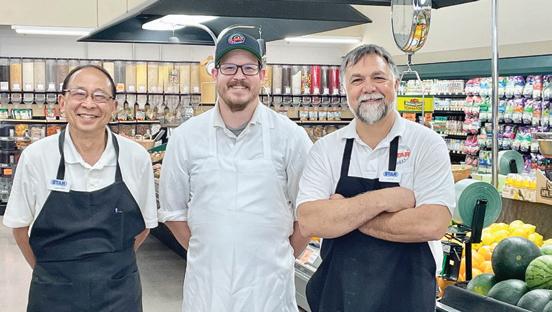




food, and an award-winning wine and cocktail program, Jacks philosophy derives from globally-inspired traditions of California Cultural Cuisine. The atmosphere at Jacks is sophisticated—never pretentious. Open daily for breakfast 6:30–10:30am, dinner 4–10pm, and bar only F-Sa 10–11pm.
Monterey Beach Hotel
2600 Sand Dunes Drive
831.394.3321 • marriott.com
Freshly refurbished, Monterey Beach Hotel sits right on Del Monte Beach with some of the best views in town. It offers three dining and cocktail hour options, including: The Lantern Room on the 4th floor serving fresh seafood paired with produce from local farms and wines curated by local winemaker Ian Brand; Tidewater on the beach, which comes with fire pits, blankets, lounge seating and a selection of hot cocktails; and Lobby Bar with equally stunning seascapes from floor-to-ceiling windows and a more casual menu of oysters, fish tacos and grilled cheese. Open daily, check website for hours.


Schooners Monterey
400 Cannery Row
831.372.2628 • schoonersmonterey.com
Residents regularly vote Schooners Best Drink With a View, and they’re not wrong. The eye candy rolls from the waves crashing on the tidal zone below to Seaside and Santa Cruz beyond, and the sippers are memorable. But that’s only part of the program. The seafood-centric menu ups the atmospheric effect with contemporary takes on a Monterey cioppino pot, seared sea scallops, Dungeness crab dip and Thai-style steamed mussels. Specialty cocktails, organic fresh-pressed juices and curated small batch beers and wine complete the affair. Open 7am–9pm daily.
Sea Harvest Restaurant & Fish Market
598 Foam Street
831.626.0547 • seaharvestmonterey.com
This fresh and casual seafood spot near Cannery Row is perfect after a day exploring the Monterey Bay Aquarium. There are grilled entrées and lots of fried options with chips, including calamari, clams, prawns, scallops and oysters. Try Sea Harvest’s popular clam chowder or a basket of crispy artichoke hearts. Open daily 9am–7pm.


Tidal Coffee
400 Cannery Row
831.645.4030 • tidalcoffeemonterey.com
Thoughtful coffee blends with organic beans headline here, but picnic-lunch goodies and house-made sandwiches also come recommended. Monkey bread, maple scones and almond croissants feature in early, followed by soups, salads and panini like the roast beef with horseradish aioli, grilled onion, slices tomatoes, smoked mozzarella and pickled peppers. The coffee shop aesthetic is cute, but the adjacent decks overlooking Monterey Bay present a superior spot to spoon a fig-mascarpone or vegan chocolate-hazelnut gelato with a fresh cortado. Open Tu–Th 6am–noon, F–M 6am–4pm.
The Wild Plum Café & Bakery
731 Munras Avenue
831.646.3109 • thewildplumcafe.com
Located in Old Monterey in a vibrant and diverse neighborhood, Wild Plum draws people from all walks of life with sustainable bistro fare that uses organic, locally sourced produce, hormone-free Diestel turkeys roasted on site, grass-fed beef and house-baked bread and pastries. Breakfasts include scrambles, omelets, and breakfast tacos and burritos and for lunch, soups, salads, paninis and burgers. Wild Plum has a new graband-go location at Ryan Ranch, with breakfast, lunch, bakery items and espresso drinks. Open W–M 7:30am–3:30pm. Closed Tu.



Sea Harvest 2420 Highway 1
831.728.7081 • @seaharvestmosslanding
Outdoor tables on a wooden deck overlooking Elkhorn Slough are the perfect place to enjoy fresh seafood hauled in by a fisherman who is part of the Deyerle family that runs the restaurant. Choose from grilled catch of the day, shrimp Louie, fish and chips or some of the best Bajastyle battered fish tacos around. Open daily 11am–7pm.
Woodward Marine Market
10932 Clam Way
831.632.0857 • woodwardmarinemarket.com
Moss Landing, population a few dozen, enjoys an outsized number of beaches, marine research institutes and, thankfully, eateries. Its newest ranks among the most inviting. WMM occupies a historic location at the Moss Landing Harbor fuel dock that delivers place-appropriate fuel for the eager eater. Clam chowder and Monterey Bay calamari lead the way on the appetizer front.
A pair of salads offers roughage with style. Plates and bowls round out the menu—think bouillabaisse, fish and chips, Woodward burger, artichoke-prosciutto sandwiches and seared fish tacos. Local wines and Prosecco available, as well as local craft beer, including Alvarado Street, Other Brother, Fruition and Corralitos brewing. Open Tu–Sa 11:30am– 6pm, Su 11:30am–4pm.
Café Guaraní 111 Central Avenue
831.747.1551 • cafeguarani.com
Family owned and operated, Café Guaraní is devoted to bringing traditional South American empanadas to the Monterey Peninsula. These are Paraguayan versions, with baked or fried options, meat filled or vegan. Chef-owner Liliana Rodas de Araujo has been making empanadas since she was six years old and is also known for her special occasion cakes, available by pre-order. The café also serves lunch sandwiches, yucca fries, croquettes and vegetarian chili. There’s a robust coffee program and several variations of yerba mate—a stimulating South American herbal tea. Open M–F 8am–3pm, Sa–Su 8am–5pm.

The Grill at Point Pinos 79 Asilomar Avenue
831.375.1313 • grillatpointpinos.com
Serving breakfast, brunch and lunch seven days a week, The Grill at Point Pinos is a beloved local’s secret located at the Pacific Grove Golf Links. In addition to views of the greens and the ocean beyond, owner Tamie Aceves makes sure the food and hospitality are way above par. Award-winning huevos rancheros and chilaquiles top the breakfast menu, but there are also eggs Benedict and bloody Marys garnished with Baker’s Bacon. Ingredients are fresh and local, and the restaurant is green certified. Open Su–M 8am–5pm, Tu–Sa 8am–7:30pm.

Julia’s Vegetarian 1180 Forest Avenue, Suite F 831.656.9533 • juliasveg.com
Voted the best vegetarian/vegan restaurant on the Monterey Peninsula for more than 10 years running, Julia’s features inspired vegan, vegetarian and gluten-free food with a touch of class. Julia’s is well known for its fresh seasonal exotic mushrooms, elevated vegan desserts and house-brewed kombucha on tap. Julia's expanded breakfast menu is a great way to start your day, featuring breakfast hand pies, candy cap French toast and a cordyceps brunch bowl. Plus, everything can be made vegan! Open daily for breakfast, lunch and dinner.















Passionfish
701 Lighthouse Avenue
831.655.3311 • passionfish.net
Specializing in sustainable seafood and locally grown produce, Passionfish is a perennial award winner and a James Beard Award finalist for its Outstanding Wine Program—with an extensive selection of local and European wines at close-to-retail prices. Mother-son owners Meral Alpay and Rasit Berk Guvenc continue the restaurant’s legacy with favorite dishes like Dungeness crab salad with avocado and spicy ginger vinaigrette, smoked trout ceviche tostaditas, albacore tuna with artichokebasil caponata and sea scallops with tomato-truffle butter, poached lettuce and savory rice custard. Open nightly 5–9pm.
Spotted Duck
542 Lighthouse Avenue, Suite 102
831.920.2662 • spottedduckpg.com
Spotted Duck brings a welcoming environment to downtown Pacific Grove. Chef/ owner Jerry Regester is hands on each night, preparing the menu with his creativity and capturing the essence of the changing seasons. A small restaurant with big flavor, a bistro-style menu and a French perspective, its motto is, “Duck is the new chicken!” Also offering great wines, local beer on tap and fun soju-based cocktails. Located in the historic Holman Building at the gateway to downtown Pacific Grove, Spotted Duck is considered one the best neighborhood restaurants by locals. Come eat, come experience the memorable food and hospitality that will have you coming back for more. Open Th–M 5–8pm

Inaka Japanese Restaurant
313 Third Street
831.593.5100 • facebook.com
Beloved by locals, Inaka has a vast menu of Japanese appetizers, soups, salads, tempura, teriyaki and noodle bowls, but most people come for the sushi. Try the San Juan roll with spicy tuna, cucumber and tempura crumbs topped with maguro, hamachi and avocado. There is also a wide selection of vegetarian rolls and a dozen different sakes, some brewed locally in San Benito County. Open W–Su 4–8pm.

Lolla
201 Third Street
831.593.5064 • lollasjb.com
Owner Sarah Griss has created a soup, salad and sandwich luncheonette in an adobe building right across the street from San Juan Bautista Historic Park. Lolla sources healthy food from local farms and food producers, giving customers a quick and convenient way to eat locally, seasonally and deliciously. Daily special soups are not to be missed. Open W–Su 11am–3pm.

Margot’s Ice Cream Parlor
211 Third Street
831.623.9262 • margotsicecreamparlor.com
Bringing smiles to the people of San Juan Bautista for 25 years, Margot’s was originally opened as a retail outlet for wonderful handmade candies, including chocolatedipped apricots, almond butter crunch, marshmallows, oreos, grahams and pretzels, as well as 10 flavors of chocolate truffles. In addition, it offers 28 flavors of Lappert’s ice cream, espresso drinks and Dole pineapple whip. Open M–Th 11am–7pm, F–Su 11am–8pm.

The Smoke Point
206 Fourth Street
831.593.5009 • thesmokepoint.com
When Michelin-starred chef Jarad Gallagher wanted a project for his own community, he immediately thought of barbecue. San Juan Bautista holds a massive rib cookoff every spring and The Smoke Point is the restaurant

he opened mid-pandemic for year-round BBQ. While most folks come for the brisket, ribs, tri-tip and pulled pork, don’t miss creative sides like Fuji apple and ginger coleslaw or crispy Brussels sprouts. There is local craft beer on tap and an imaginative weekend BBQ brunch. Open W–Th noon–8pm. F noon–9pm. Sa 10am–9pm. Su 10am–8pm.
Vertigo Coffee Roasters
81 Fourth Street
831.623.9533 • vertigocoffee.com
Artisanal coffee roasted on site as well as fresh pastries baked in-house, brunch items, local craft beers and wines, plus wood-fired pizzas with naturally leavened, twice fermented sourdough crust have made Vertigo a locals’ favorite as well as a great find for visitors en route to the San Juan Mission, Pinnacles or other area attractions. Check website for current hours.


Windmill Market
301 The Alameda
831.623.2956
San Juan’s friendly neighborhood grocer has everything you need for a picnic or quick meal, with ample outdoor tables and booths around the windmill. A full-service deli counter and taquería offers made-to-order sandwiches and Mexican specialties like tortas, burritos, tamales and combo plates. There is also a salad bar, a hot bar and plenty of grab-and-go items. Open daily 6am–9pm.
Avanti Restaurant
1917 Mission Street
831.427.0135 • avantisantacruz.com
A local’s favorite since the 1980s, Avanti pioneered farm-to-table dining and the use of organic, local vegetables, pasture-raised meats and sustainable seafood. Favorite dishes include calamari fritti, Brussels sprouts with roasted butternut squash and fresh pappardelle pasta with pork meatballs. On Sundays it offers Fogline Farm fried chicken dinners. Diners can choose the upscale contemporary dining room, a heated outdoor patio or the garden room. A full bar features seasonal cocktails, along with local wines and craft beer. Open W–Su 5–9pm.


Bookie’s Pizza 1315 Water Street bookiespizza.com
Located inside the Santa Cruz outpost of Sante Adairius Rustic Ales, Bookie’s Pizza is owned by fine dining veteran chef Todd Parker and offers “inauthentic” Detroit-style square pies. Each pizza is made using the best seasonal ingredients from local farms, fishermen and foragers. Dough is made with organic flour, naturally leavened for 48 hours, and each pizza comes with its own unique sauce. Open Su–Th noon–9pm. F–Sa noon–10pm.
Charlie Hong Kong 1141 Soquel Avenue 831.426.5664 • charliehongkong.com
Charlie Hong Kong has been providing the Santa Cruz community with healthy, sustainable, affordable and high-quality food since 1998. The colorful, casual eatery’s delicious fusion of Southeast Asian influences and the Central Coast’s local organic produce have made it an inclusive, family-friendly, neighborhood favorite. Its slogan is “love your body, eat organic,” and its cuisine is proof that fast food can be good for you. All signature dishes are vegan with the option to add meat or fish. Gluten-free options are available. Dog friendly. Open daily 11am–10pm.

Housemade pasta for Seabright, Santa Cruz and the world since 2006.
538 Seabright Ave | 831-457-2782 lapostarestaurant.com
Wednesday through Sunday, we open at 5pm.
105 Walnut Avenue • eathookandline.com
831.225.0434 • 4-9pm Thursday through Monday
A modern California seafood eatery, now open in downtown Santa Cruz.

Tune in Fridays around noon for Edible’s Mark C. Anderson and his Friday Found Treasures on 94.7 FM and streaming worldwide at KRML.com!
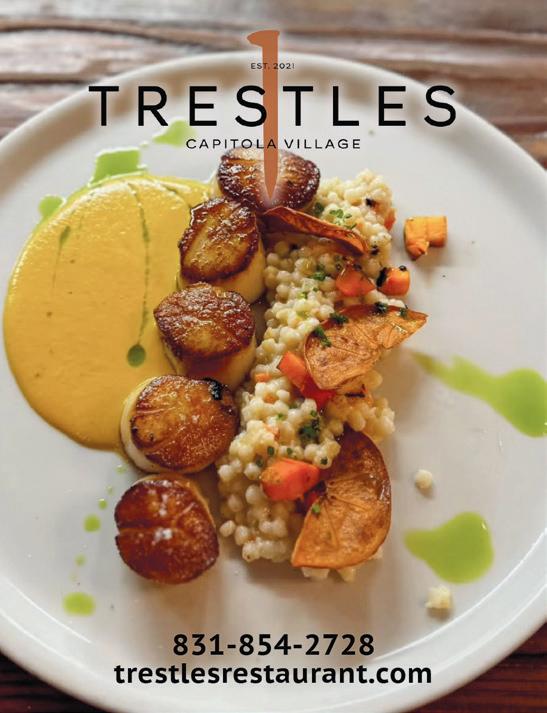



Crow’s Nest
2218 E. Cliff Drive
831.476.4560 • crowsnest-santacruz.com
A perfect spot to enjoy breakfast and lunch or catch a dinnertime sunset over the harbor, the nautical-themed Crow’s Nest is a Santa Cruz institution that never goes out of style. There’s always something happening, from live music to comedy nights and happy hours. Famous for its salads, house-smoked salmon and seafood entrées, the Crow’s Nest is a member of Seafood Watch and is a certified green business. Open M–F 9am–8:30pm, Sa–Su 8am–8:30pm.
Far West Fungi
224 Laurel Street, Suite A101
831.226.2626 • farwestfungi.com
The air surrounding the cozy café in downtown Santa Cruz is always infused with the delightful scents of savory mushrooms and truffles. Each visit offers a fresh experience with the seasonal menu featuring a variety of cooked and fresh mushrooms, while the extensive selection of dried mushrooms, tinctures, books and cultivation supplies ensures your pantry stays stocked with rare foraged treasures. Indulge in must-try delights like candy cap mushroom cookies, hot mushroom empanadas and truffle grilled cheese, complemented by locally brewed kombucha on tap. Open daily 11am–5pm.

Gabriella Cafe 910 Cedar Street
831.457.1677 • gabriellacafe.com



A charming dining spot inside a Spanish-style bungalow, Gabriella Cafe pioneered farm-to-table cuisine in Santa Cruz. Head chef Gema Cruz serves a seasonal CaliforniaItalian menu starring organic produce from local growers and the nearby farmers market, as well as humanely raised meat and sustainable seafood. There is a candlelit patio and a cozy dining room that showcases the work of local artists. Open for lunch Tu–F 11:30am–2:30pm, dinner Tu–Sa 5–9pm, brunch Sa–Su 10am–2:30pm.
Hanloh Thai Food 1011 Cedar Street
831.854.7525 • hanloh.com









This community favorite from chef-owner Lalita Kaewsawang offers standout “nostalgic cooking rooted in Thai tradition,” at a residency inside the stylish Bad Animal bookstore. Bright flavors begin with Hatsu oysters with nam jimm dipping sauce and pomelo-grilled shrimp salad tossed with chili jam dressing and Thai herbs. Entrées include lemongrass black cod, claypot pork belly confit and double fried chicken thighs with coriander. That all comes complemented by friendly hospitality and a wide selection of natural wines. Open W–Su 5–9pm.
Hook & Line
105 Walnut Avenue
831.225.0434 • eathookandline.com
Chef Santos Majano makes a welcome return to the Santa Cruz dining scene with his own seafood concept restaurant. Hook & Line taps local fishermen for the best fish and shellfish, then adapts the menu, whether it’s octopus, mussels, California halibut or just-caught Monterey Bay sardines. Oysters play a big role with a custom designed shucking station and several varieties on offer at all times. Happy hour all night Mondays and 4–5pm Th–Su features $2 oysters and special prices on wine and craft cocktails. Open Th–M 4–9pm.
Johnny’s Harborside
493 Lake Avenue
831.479.3430 • johnnysharborside.com
With sweeping views of the Santa Cruz Yacht Harbor, Johnny’s location assures fresh off the boat seafood. Steamed Dungeness crab with drawn butter is always a good choice in season, but don’t miss the clam chowder, fish and chips or Johnny’s authentic Italian-style ciop

pino. Crab-encrusted salmon, shrimp scampi and California halibut entrées are customer favorites, along with fish tacos, burgers and beer-steamed clams. Open T–Su noon–8:30pm. Closed M.
Laílí
101B Cooper Street
831.423.4545 • lailirestaurant.com
Exotic flavors of The Silk Road are served in a stylish dining room decorated in eggplant and pistachio colors and on a hidden candlelit patio. Locals rave about Laílí’s homemade naan served warm from the oven with a selection of Mediterranean dips. There is a wide variety of deliciously spiced vegetable dishes, and all meats are hormone free and free range. Open Tu–Sa 4–8pm.

La Posta
538 Seabright Avenue
831.457.2782 • lapostarestaurant.com
A cozy neighborhood bistro not far from the Santa Cruz yacht harbor, La Posta chef Rodrigo Serna prepares traditional rustic Italian cuisine using local ingredients. The emphasis is on simple, seasonal selections, with the balance of the menu reflecting whatever produce is freshest right now. La Posta also offers a great selection of Italian wines and a heated outdoor patio. Open W–Th 5–8:30pm, F–Sa 5–9:30pm, Su 5–8:30pm. Closed M–Tu.


The Midway 1209 Soquel Avenue
831.427.7187 • themidwaysantacruz.com
Acclaimed Santa Cruz chef Katherine Stern pivoted from running a popular farmers market stand during the pandemic to opening her own restaurant at the end of last year. The vibe is sleek and modern, and the food is sophisticated. Whether you try the lemon verbena pancakes, the chicken chile verde or one of the salads from the daytime menu, all dishes star seasonal produce and ingredients from Stern’s farmers market friends. Dinner options change frequently and always include a house-made pasta and a vegetarian entrée. Check website for the most updated menu. Carefully selected wines, beer and coffee roasted by Cafe Delmarette are available. Open Th–M 11am–2pm and 5–8:30pm, Sa–Su until 9pm.
New Leaf Community Markets
1101 Fair Avenue
831.426.1306 • newleaf.com
The Westside New Leaf has a large deli counter and coffee bar, with a big selection of sandwiches, salads, bakery items, soups and other hot foods. You can eat at an instore counter or at tables outside. Open daily 7am–9pm.


The Penny Ice Creamery
913 Cedar Street
831.204.2523 • thepennyicecreamery.com
Lines out the front door of its converted Spanish bungalow are evidence of Penny’s popularity. All ice cream, including bases, is made from scratch on the premises using local organic ingredients when possible. Dozens of exotic flavors rotate seasonally, but two favorites are chocolate caramel sea salt and strawberry pink peppercorn. Open daily noon–11pm.
The Picnic Basket
125 Beach Street
831.427.9946 • thepicnicbasketsc.com
Across the street from the main beach, owners of The Penny Ice Creamery offer an alternative to boardwalk fast food. Sandwiches, organic salads, coffee and beer, all from local food artisans, and of course Penny’s popular ice cream, are all on offer to eat in or outside with your feet in the sand. A selection of grab-and-go foods, drinks and beach essentials are available in the newly expanded restaurant. Open daily 7am–4pm.





Carmel Rancho Shopping Center

Staff of Life
1266 Soquel Avenue
831.423.8632 • staffoflifemarket.com
A Santa Cruz landmark, Staff of Life started in 1969 as a small natural foods bakery and has grown over the years into a full service natural foods supermarket known for its local organic produce, seafood and natural meats as well as an extensive bulk department. Deli items and foods from the hot bar can be enjoyed at the Café del Sol. Open daily 8am–9pm.
Vim Dining & Desserts
2238 Mission Street
831.515.7033 • vimsantacruz.com
Chef-owner Jesikah Stolaroff brings creativity and precision to her elegant New American cuisine, giving diners a clue to her background as a fine dining pastry chef. The seasonal menu might include appetizers like kimchi rice fritters, lamb meatballs or cherry burrata, with entrées such as pineapple trout, leek butter fettuccine or coriander crusted filet mignon—served in a tasteful dining room with a full bar or on the outdoor patio. Save room for unforgettable desserts and check website for monthly afternoon teas. Open W–Sa 5–8:30pm.

The Penny Ice Creamery
262 Mount Hermon Road, Suite 104 831.204.2523 • thepennyicecreamery.com
Open Su–Th noon–9:30pm, F–Sa noon–10pm. See The Penny description under Santa Cruz for more.
Other Brother Beer Co. 877 Broadway Avenue 831.747.1106 • otherbrotherbeer.com
The main attraction here is fresh, delicious beer. However, the brewery’s brand new kitchen inspires a visit on its own. Not coincidentally, dishes are designed to pair poetically with Other Brother’s house beers. The menu features goodies like its signature smashburger, fried chicken sandwich, mushroom melt, wings, fries, and creative and refreshing salads with occasional local food pop-ups. Check out the full menu on the website and visit the brewery taproom open M–Th 11:30am–9pm, F 11:30am–10pm, Sa 11:30am–10pm, Su 11:30am–8pm.


Coffeeville
948 East Lake Avenue facebook.com/coffeevillesantacruz
Local family owned and operated, Coffeeville prides itself on its dedication to single origin coffees roasted in small batches. It’s the perfect spot to enjoy a cappuccino or an espresso, offering a warm and lively atmosphere that gives a great start to your day. Organic teas, affogatos, pastries and breakfast sandwiches are also on the menu. Open M–Sa 7am–4pm, Su 8am–3pm.
Fruition Brewing & Kitchen
918 East Lake Avenue
fruitionbrewing.com
Fruition serves seafood and comfort food with delicious craft beers made on-site. The brewpub offers a rotating selection of beers with attention to balance, using the finest local, organic and California-grown ingredients with attention to balance and refreshing precision. The kitchen cooks with the seasons, featuring stunning snacks, salads, soups, outstanding oysters and gourmet grilled cheeses to pair with the super fresh beers, local cider and wine. Check their calendar for events in the tasting room and on the pet-friendly patio, including First Friday art, trivia nights and karaoke. Open W–Th noon–9pm, F–Sa noon–10pm, Su noon–8pm.

Gizdich Ranch
55 Peckham Road
831.722.1056 • gizdich-ranch.com
Visitors from all over love this fourth-generation, familyrun farm business that popularized the “pik-yor-self” experience just east of Watsonville. Tour the farm, pick fresh apples or berries or watch the action inside the juice-pressing barn. No one leaves hungry if they spend time at the bakery-deli that pleases with its fresh pies, shortcakes and pastries, along with hearty sandwiches and box lunches. This family-friendly experience is also a treat for kids, who will enjoy the wide-open spaces and the homemade popsicles. Open daily 9am–5pm.
Hong Kong Garden
1012 E. Lake Ave.
831.724.1188 • qmenu.us
Watsonville’s go-to spot for fresh Chinese food, Hong Kong Garden offers dine in and take out service. There is a friendly, family vibe and a large dining room tucked into a corner of the East Cliff Village shopping center. Reasonably priced classic Chinese dishes are prepared to order, including Hong Kong style noodles and sizzling rice soups. Two dozen lunch specials, including rice, come in at $10 or $11. Open W–M 11:30am–8:30pm.

Ozzy’s Pizzeria
1036 East Lake Avenue
831.319.4464 • ozzyspizzeria.com
Ozzy’s motto is “Pizza is Life,” and owner Tim Silva’s casual yet creative style translates to both the ambiance and the food. Crowned World Pizza Maker of the Year in 2015, Silva makes sure everything is made from scratch, using organic ingredients, including the sauces and the outstanding sourdough crust—which is expertly charred in the wood-fired oven. Vegan, vegetarian and gluten-free options are available, and online orders can be placed through the website. Open Su–M noon–8pm, W–Th noon–8pm, F–Sa noon–9pm. Closed Tuesday.

Silver Spur
1040 East Lake Avenue
East Lake Village is excited to add a Santa Cruz County institution to its dining roster, Silver Spur! Opening in March of this year. The original Silver Spur restaurant, specializing in breakfast and lunch, opened in the 1960s and has a loyal following of regular customers who come for signature orange rolls, cinnamon rolls, bread pudding, and dozens of egg dishes. Father and son owners Juan Valencia and Daniel Govea also offer homemade soups, sandwiches and heartier items like chicken-fried steaks, oven-roasted turkey, and roast beef.
Staff of Life


906 E. Lake Avenue
831.726.0240 • staffoflifemarket.com
Opened in 2021, Staff of Life’s second store in Watsonville is its first and only branch. The store is sustainable down to its bones and includes all the natural groceries, organic produce and includes all the natural groceries, organic produce and baked goods you would find at the Santa Cruz store, along with a juice and smoothie bar, freshly made sushi, a gelato bar, a full deli and a hot bar. Open daily 8am–8pm.
Sushi Qu
952 East Lake Avenue
831.319.4567 • instagram.com/sushiqu1
The place to go for sushi, sashimi, tempura and other Japanese specialties, Sushi Qu puts the emphasis on freshness and flavor. Menu items are available for dine -n or takeout, and if you’re in need of platters for your next event, Sushi Qu can do that as well. Check out the monthly specials on Instagram and Facebook. Open Tu–Th 11:30am–2pm and 5–8pm, F 11:30am–2pm and 5–8:30pm, Sa 11:30am–2:30pm and 5–8pm.


831-724-7581
sales@sambrailo.com


Pop & Hiss record store debuts a virtuoso drink menu amid overblown drama
STORY BY MARK C. ANDERSON
PHOTO BY KELLY ROSE EVANS
Like everything at record store-performance venue Pop & Hiss in Pacific Grove, the new cocktail program draws inspiration from music—title tracks on landmark albums, no less.
The flavor profiles they inspire happen to be balanced—and even beautiful—as with the “Featured Track” at the top of the menu, “Purple Rain.”
The drink proves earthy, bright and botanical, with a deep indigo hue thanks to the butterfly pea flower blossoms that infuse the Empress 1908 gin it’s built around. That comes complemented by cascading Luxardo cherry liqueur and juiced cilantro worthy of an iconic talent.
“Because it’s Prince,” Pop & Hiss inventor-owner-operator Michaela Kuenster says, “we have to do right by him.”
That meant intentionally avoiding the formula adopted by many predecessors. “There are 9 million versions with blue liqueurs that belong in plastic foot-long glasses for walking around Vegas,” Kuenster adds. The Pop & Hiss is the result of what its cocreator Stephanie Kahn calls “a collaborative process” between Kuenster, fellow bartender Jackson Dowd and herself.
“It’s familiar, but kind of unexpected,” Kahn says. “A lot of recipes fall back on sweet flavors, but I don’t like things to be too cloying.”
From there the hits include the “Court and Spark” named for the Joni Mitchell classic, with Four Roses bourbon (a nod to her album For the Roses), grapefruit, lemon, honey and pepper; the “Rhinestone Cowboy” of Glen Campbell fame, with Pendleton rye whisky, sarsaparilla syrup and candied ginger; and the “Private Dancer” of Tina Turner heritage, with Arette Reposado tequila, Borghetti coffee liqueur, coffee and sea salt.
Those creations fit into a full-bodied lineup that complements the curated retail vinyl inventory, two performance stages and regular food trucks. Lead mobile operation of late is La Pizza Piccolo, that pulls up Wednesday–Sunday to roll out classics and monthly specials like the artichoke-lemon and the 18-hour smoked brisket pizzas.
There also appear “LoFi” lower ABV options, six mule variations; “Greatest Hits” like lemon drops, paper planes and brown derbies; and “The Wrecking Crew,” a $45 group order of four shots and four beers named for a legendary backing band.
When Edible broke word of Pop & Hiss’ debut as a cocktail lounge with food and music last fall, Kuenster, who also teaches piano, described how deeply ingrained music is for her.
“I still remember my tiny Fisher-Price toy record player, and my dad’s a musician, so I grew up backstage, and collecting records,” Kuenster said.
“I love records, I love bars, I love music. Why not put them all together?”
And though Kuenster and company have gone to extreme lengths (and endured extremely long P.G. Planning Commission and City Council meetings) to make sure the shop’s decibel levels and closing time honor conservative restrictions, something telling has happened along the way.
Beyond the popular and far-ranging live music—nights built around everything from soul, funk and hip-hop to Latin vinyl showcases to goth-and-tarot card nights—Pop & Hiss has gathered momentum despite frivolous noise complaints and overactive police badgering. (While earning a largely overjoyed response.)
“It’s not a raucous place,” Kuenster says. “Some are expecting it’s going to be Viper Club with celebrities ODing in the doorway, but it’s bluegrass on Thursdays, all ages, and kids buying their first record while dad has a beer, all over and dark by midnight.”
Dowd, who’s tended bar for decades around the area, provides additional context.
“Every album in that store—and there are tens of thousands—is someone’s dream,” he says. “This is concentrated culture, a museum where you can come in to look for free and listen for free. People deserve to have access to that.”
Somewhere Prince—who once said, “I like to open people’s eyes”— is raising a glass.

